Star Trek: Deep Space Nine
Star Trek: Deep Space Nine was the fourth Star Trek series and entered production in 1992 . It was broadcast in first-run syndication from January 1993 until June 1999 .
It was the first Star Trek series created by Rick Berman and Michael Piller rather than by Gene Roddenberry . It was also the only series to air alongside another Star Trek production throughout its entire run, airing alongside Star Trek: The Next Generation from 1993 until 1994 , and then with Star Trek: Voyager from 1995 until 1999 .
- (Themes composed by Dennis McCarthy ).
- 1.1 The characters
- 1.2 Alien races
- 1.3 The mirror universe
- 1.4 Technology
- 1.5 Costumes
- 2.1 Development
- 2.2 Serialization
- 3.1 Starring
- 3.2 Also starring
- 3.3 Special guest stars
- 3.4 Special appearances by
- 3.5 Recurring characters
- 4 Executive producers
- 5 Staff writers
- 6.1 Season 1
- 6.2 Season 2
- 6.3 Season 3
- 6.4 Season 4
- 6.5 Season 5
- 6.6 Season 6
- 6.7 Season 7
- 7 Related topics
- 9 External links

Summary [ ]
Deep Space Nine goes where no Star Trek series had gone before – DS9 was the first Star Trek production not based on a starship , but instead, a starbase , known as Deep Space 9 (the starship USS Defiant was introduced in season 3, but the station remained the primary setting of the series). The show is known for its complex characters and storylines, engaging battle scenes and darker (less Utopian) atmosphere. Unlike its predecessors Star Trek: The Original Series and Star Trek: The Next Generation , Deep Space Nine tended to avoid an episodic format for most of its run and instead featured multiple-episode story arcs .
The show broke the "standard format" for Star Trek shows a number of times as well, with a direct, first-person narrative providing the commentary for the episode " In the Pale Moonlight ", a retelling of a classic TOS episode from a different angle in " Trials and Tribble-ations ", life in the racially segregated 1950s in " Far Beyond the Stars ", and a reintroduction of the concept of "black ops" to the Star Trek universe with Section 31 : " Inquisition ". The show also broke with tradition – and with the two Star Trek series that followed it – by featuring a commanding officer as the star of the show at the rank of commander, rather than captain, for a significant portion of its run, until Sisko was eventually promoted to captain in " The Adversary ". Additionally, a number of the episodes and main storylines focused entirely on characters who weren't members of Starfleet: for example, those revolving around Kira, Odo, Jake Sisko, and Quark. (" Progress ", " Shakaar ", " The House of Quark ", " Heart of Stone ", " Prophet Motive ", " Little Green Men ", " Bar Association ", " Body Parts ", " Nor the Battle to the Strong ", " The Ascent ", " The Darkness and the Light ", " Business as Usual ", " Ties of Blood and Water ", " Ferengi Love Songs ")
The characters [ ]
Unlike other Star Trek series, DS9 also had a large cast of recurring characters . Such characters included Nog , Rom , Elim Garak , Dukat , Vedek Bareil Antos , Winn Adami , Weyoun , the Female Changeling , Damar , Martok , Kasidy Yates , Leeta , Brunt , Ishka , and Zek .
Miles O'Brien , and later Worf , were two characters imported from TNG. Worf – a major character from TNG – played a large role on DS9. Several Next Generation characters also had recurring roles on the show, such as Keiko O'Brien and Gowron . Several other TNG characters made appearances too, such as Captain Jean-Luc Picard , Thomas Riker , Q , Lwaxana Troi , Kurn , Lursa , B'Etor , Admiral Alynna Nechayev , Vash , Toral and Alexander Rozhenko . In addition, Julian Bashir and Quark also had one-time appearances on The Next Generation , in " Birthright, Part I " and " Firstborn " respectively. Quark (and the station itself) also made a cameo in the pilot of Star Trek: Voyager , " Caretaker ". Characters from The Original Series were also re-introduced in DS9, including Kor , Kang , Koloth , and Arne Darvin .
The series also featured a number of episodes in which the character of Miles O'Brien was subjected to particular trauma. This became an in-joke among the DS9 writing staff, who called them "O'Brien Must Suffer" episodes and went to great lengths to produce at least one such episode per season. ( Star Trek: Deep Space Nine Companion , p. ? )
Alien races [ ]
The series focused on several races that were first featured on TNG, such as the Bajorans , the Cardassians , the Trill , and the Ferengi . Later, the Klingons and the Romulans (both created in TOS) became pivotal species in the series. Many other species made appearances on the series, including Vulcans , Bolians , and Benzites . The series also created many species of its own, most notably the Changelings , the Vorta , and the Jem'Hadar , who formed part of the Dominion .
Jadzia Dax and other Trills portrayed in DS9 were distinctly different from how Trills had been depicted in the TNG episode " The Host ". In DS9, the relationship between host and symbiont was described more as a truly symbiotic relationship rather than the symbiont dominating the host. Trills now having spots, rather than prosthetic make-up, was due to studio executives feeling that Jadzia Dax actress Terry Farrell was too attractive to cover her face up. ( Cinefantastique , Vol. 23, No. 6, p. 21)
Another significant change was the relationship Ferengi had with Humans . The Ferengi on TNG had originally been intended to be a new adversary comparable to the Klingons in TOS, although the writers had quickly realized how ridiculous the Ferengi were as villains. In DS9, the Ferengi were mainly entrepreneurs and the Ferengi Alliance was a politically neutral economic power.
Deep Space Nine also featured several regular characters who were not members of Starfleet , with Kira Nerys , a member of the Bajoran Militia , and Odo , the station's chief of security , as well as civilians such as Quark and Jake Sisko .
The mirror universe [ ]
The series spent some time exploring the mirror universe , which had not been seen since the TOS episode " Mirror, Mirror ". The mirror universe was featured in five episodes of the series: " Crossover ", " Through the Looking Glass ", " Shattered Mirror ", " Resurrection ", and " The Emperor's New Cloak ".
Technology [ ]
The show also focused on a wider array of uses and depictions of functions for holographic simulations (known as a holodeck in TOS and TNG but as a holosuite in DS9). In addition to many obvious activities (such as those referenced by Chief O'Brien and Julian Bashir) which were completely in keeping with holodeck usage on The Next Generation , the numerous applications of the holosuites on DS9 included them being used as: a recurring background for people to hang out in, in the form of a 1960s Las Vegas lounge (in numerous episodes); a weapons showroom (by Quark); and the location for a baseball game between teams assembled by Sisko versus Solok , a long-time rival Vulcan captain (in " Take Me Out to the Holosuite ").
Costumes [ ]
DS9 initially featured a noticeable change in Starfleet uniform to a reversed color scheme of the TNG uniform, which is a black design with the division color on the shoulders and a grayish-indigo undershirt underneath the uniform, resembling the cadet uniforms seen on The Next Generation . This design is called the old DS9-style uniforms . It was mostly implemented as a continuation of Star Trek 's pattern of changing uniforms over time, although factors such as the discomfort of wearing TNG-style uniforms played a role as well.
What came to be known as the DS9-style uniforms were more of a variant than a switch, however, due to the cost of producing all-new uniforms. This is why, for example, the DS9 crew themselves wear old DS9-style uniforms from the beginning of DS9 pilot episode " Emissary " up to the fifth season episode " The Ascent ", and this style was also later used throughout Star Trek: Voyager . Meanwhile, even after TNG had gone off the air, the dress uniforms and flag officer uniforms on DS9 up until the sixth season (as well as uniforms on Earth , as seen in the fourth season episodes " Homefront " and " Paradise Lost ") were " TNG-style ".
These discrepancies were corrected with the later switch to a unified, "gray-on-black" format with the division color undershirts (known as the “ DS9-style ”), which was used through Star Trek Nemesis and were also used in this series, starting with " Rapture " and for the remainder of this series, though the old DS9-style uniforms in this series appeared four more times following the uniform change in the episodes, " In Purgatory's Shadow " and " By Inferno's Light " as well as seen on a photograph of " Field of Fire " and in the flashback scenes of " What You Leave Behind ".
Background information [ ]
Development [ ].
The decision to set the series on a space station, rather than a starship, spawned when Brandon Tartikoff originally approached Rick Berman about the show, in 1991, and specifically said he wanted it to have a format that was new for Star Trek but was classically western; if The Next Generation was Wagon Train in space, Deep Space Nine was to be The Rifleman in space – a man and his son coming to a dilapidated frontier town on the edge of known civilization. Berman brought this concept to Michael Piller , and together they set about creating a western in space. As Robert Hewitt Wolfe later explained, " We had the country doctor , and we had the barkeeper , and we had the sheriff and we had the mayor , we had it all, it was all there. We had the common man, Miles O'Brien , the Native American, Kira . " Indeed, the producers initially discussed setting the show at a colony on an alien planet rather than on a space station. This idea was ultimately rejected because it was felt that it would involve too much location shooting, and because they felt that fans of Star Trek wanted to see story lines set primarily in space , not on a planet. ( New Frontiers: The Story of Deep Space Nine , DS9 Season 2 DVD special features)
The change of venue to a space station was largely intended to differentiate DS9 from The Next Generation , because the producers felt that having two shows about a starship airing simultaneously would be unacceptable. As co-creator and executive producer Rick Berman later explained, " Because there were two years of overlap with The Next Generation , we could not create a show that took place on a spaceship. It just seemed ridiculous to have two shows and two casts of characters that were off going where no man has gone before. It was a land-based show, it was a show that in a sense was taking place on a space station. So it had to be an entirely different concept. " ( Deep Space Nine: A Bold Beginning , DS9 Season 1 DVD special features)
The decision to set the show on a fixed station rather than a traveling starship was also based upon a desire to look deeper into the actual workings of the Federation and to see how it dealt with the type of problems one wouldn't find in a show set upon a starship. Michael Piller felt that, by having the characters standing still, they would be forced to confront issues not usually applicable to people on a starship. Whereas on The Next Generation , issues raised each week could simply be forgotten about the following week as the ship visited somewhere else, on a space station, events couldn't be forgotten or left behind but instead had to have implications for the future. As Piller explained, " We didn't want to have another series of shows about space travel. We felt that there was an opportunity to really look deeper, more closely at the working of the Federation and the Star Trek universe by standing still. And by putting people on a space station where they would be forced to confront the kind of issues that people in space ships are not forced to confront. In a series that focuses on a starship, like the Enterprise , you live week by week. You never have to stay and deal with the issues that you've raised. But by focusing on a space station, you create a show about commitment. It's like the difference between a one-night stand and a marriage. On Deep Space Nine , whatever you decide has consequences the following week. So it's about taking responsibility for your decisions, the consequences of your acts. " ( Star Trek: Deep Space Nine Companion , p. ? ) Similarly, in 2002 , Piller stated, " If you look at The Next Generation , it's really about movement. You don't ever stay in one place long enough to get to know anybody. Well Deep Space Nine is a show where everybody is forced to stay week after week, so each episode, each show, is fundamentally dealing with the people who have to learn that actions have consequences, and they have to live with the consequences of their actions on a weekly basis. " ( New Frontiers: The Story of Deep Space Nine , DS9 Season 2 DVD special features)
Setting the show in a fixed location meant that a large cast of recurring characters could be built up with relative ease; much more so than in The Original Series or The Next Generation before it, or Star Trek: Voyager , Star Trek: Enterprise , or Star Trek: Discovery since. As Rick Berman, speaking in 2002, stated, " The show was land-based, but the benefit we got from that was that by staying in one place, it enabled us to create twenty or thirty secondary and recurring characters, which really enriched the show because of all the multi-layers of relationships that have existed over the years. It's a very character-driven show as a result, and I think that makes it quite unique. " ( Deep Space Nine: A Bold Beginning , DS9 Season 1 DVD special features)
The decision to set the show in a fixed location was regarded as a benefit by the series' staff writers. For example, Ira Steven Behr , speaking in 1996 , commented, " We have certain advantages that I think no other Star Trek series has had, because we do have a base of operations that doesn't travel through space, which is the space station. Every story we do, the repercussions, the consequences don't disappear. It's not like the other shows where you have an adventure and then you zoom off into the great unknown. We are here, we have made a home, what we do has consequences. And I think we're able to do this mosaic, this fabric of life in the future, which I like. " Similarly, Robert Hewitt Wolfe, speaking in 2002, stated, " I think if Next Generation and The Original Series were about going out there and discovering new things about other races, Deep Space Nine is about staying in one place and discovering new things about ourselves. Not that we didn't go out there and discover things, but we had the same characters, we didn't change location every week. Sisko couldn't just solve a problem and sail off into the sunset, and never have to go back to that place again. That place was always there, and that problem could always come back to haunt him. So, in a lot of ways, it was a more complex show. " ( New Frontiers: The Story of Deep Space Nine , DS9 Season 2 DVD special features)
The series was designed to have more interpersonal conflict than its predecessors, while still staying true to the universe that Gene Roddenberry had created. Rick Berman commented, " [Deep Space 9]'s an alien space station that doesn't work the way they want it to, and that in itself created a lot of conflict. At the same, our core characters are Starfleet officers; Sisko, O'Brien, the doctor and Dax in no way vary from The Next Generation in terms of the lack of conflict among themselves. That was a rule we had to follow. " ( Captains' Logs Supplemental - The Unauthorized Guide to the New Trek Voyages , p. 5) Berman also commented, " What we wanted to do was something that was almost paradoxical – bring conflict but not break Gene's rules. They still play paramount importance in what we're doing. We created an environment where Starfleet officers were in a location that they weren't happy about being in, and they were in a location where the people who lived there weren't all that happy about them being there. " ( Captains' Logs Supplemental - The Unauthorized Guide to the New Trek Voyages , p. 8)
The show's main cast was intentionally assembled to create conflict (Quark and Odo, Kira and Sisko, etc.), so as to contrast the relatively tranquil atmosphere aboard Federation starships. This was another very specific decision taken by the producers. Gene Roddenberry's golden rule was that there was to be no conflict among Starfleet characters, so the producers decided to introduce non-Starfleet characters so conflict could come from within the show rather than always coming from outside (as it did on TNG). Rick Berman recalled, " We [....] created a situation where we had people who were members of our core group who were not Starfleet: the security shapeshifter Odo; the Bajoran Major, Kira; the bartender, Quark. A group of our integral people are not Starfleet officers, and the ones that are Starfleet officers aren't crazy about where they are, so we have a lot of frustration and conflict. " ( Captains' Logs Supplemental - The Unauthorized Guide to the New Trek Voyages , p. 8) Writer Joe Menosky explained, " You can see right away they're not the perfectly engineered Humans of TNG. They seem more real. I don't know if that makes them as attractive to viewers or not. But they are really different, and they represent a different way to tell a story. And it was definitely a conscious choice to create that potential for conflict. " Similarly, Berman stated, " Viewers didn't see that group of loving family members that existed on the first two Star Trek shows. " ( Star Trek: Deep Space Nine Companion , p. ? ) Michael Piller also commented on this somewhat controversial aspect of the show; " One of the primary goals of the development process was to come up with a show that had more inherent conflict than The Next Generation . In order to do that, you have to understand that Gene Roddenberry had a very specific vision for Humanity in the 24th century. What that meant for The Next Generation was that everybody gets along remarkably well on the Enterprise . There's very little room for interpersonal conflict between those people. In this series, we set out to create a situation that would provide natural conflict. We've populated the show with several aliens, primarily Bajorans , as we are stationed on the edge of the Bajoran star system . And the Bajorans are very different people than we are. They are people who are very spiritual and mystical and have a whole different way of looking at life than the 24th century humanist views which many of our Starfleet people will have. So immediately, there are conflicts. And then there's additional aliens from elsewhere who are thrown into the mix. So, as regular characters, not all the people are Starfleet, not all the people are Human, and as a result, you have this continuing conflict, because people who come from different places, honorable, noble people, will naturally have conflicts. " ( Deep Space Nine: A Bold Beginning , DS9 Season 1 DVD special features)
Unlike with TOS and TNG, Gene Roddenberry wasn't directly involved in conceptualizing DS9. Regarding Roddenberry's involvement in the series, Rick Berman stated, " Michael and I discussed it with Gene when we were still in the early stages, but never anything conceptual. " " We never got a chance to discuss it (the concept) with Gene. By the time we had it to the point that it was discussable, he was in pretty bad shape and not really in the condition that it would have been wise to discuss it with him. On two specific occasions I was with him at his house and we tried to bring it up, but it wasn't really appropriate. " ( Captains' Logs: The Unauthorized Complete Trek Voyages , p. 328) Director Paul Lynch remarked, " My gut feeling is that Gene would be jumping up and down. This is definitely a different take on what Gene spawned, but I think he would love it [....] While it's quite different, Deep Space Nine is also, in many ways, quite the same. All of Gene's moral requirements are upheld in this show. If we've done anything, we've expanded on what Gene created. " ( The Official Star Trek: Deep Space Nine Magazine issue 1 , pp. 10 & 12)
Initially, Berman and Piller were at a loss for a title for the series and toyed with calling the series "The Final Frontier". During further development, the station was temporarily dubbed "Deep Space Nine", which not only stuck permanently as the name of the station, but also the title of the show itself. Despite this, the two co-creators were reportedly dissatisfied with the name. ( Trek: Deep Space Nine: The Unauthorized Story , pp. 17-18)
Miles O'Brien was brought aboard DS9 and made a part of the space station's senior staff because the producers felt that Colm Meaney was too talented an actor to confine his character to a transporter room . Additionally, they hoped the TNG crossover would help boost the new series' ratings.
In the Star Trek: Deep Space Nine Companion , p. ? , Michael Piller explained the rationale behind each of the principal cast members, why each character was chosen, and what each one was to bring to the mix;
- Jadzia Dax: " The Trill is a great race. They had some interesting ramifications on TNG. A Trill character would provide great potential for dichotomy and paradox. "
- Odo: " We knew that we needed some kind of Data / Spock character who looks at the world from the outside in. And the idea that an alien entity would have to find some way to pass as Human was fascinating, and seemed to give us an avenue into the kind of 'complexion of Humanity' stories that we wanted to tell. "
- Quark: " A Ferengi would provide the show with instant humor and built-in conflict. I saw Quark as the bartender who is a constant thorn in the side of law and order, but who has a sense of humor about it. He'd be someone who could obviously throw lots of story dynamics into play. "
- Julian Bashir: " We decided to create a flawed character. He'd have to be brought down to size in order to grow. And we wrote him as kind of a jerk for much of the first season . "
- Miles O'Brien: " After we decided we were bringing him over to the new show, we thought, 'How do we use him?' We'd already decided to focus on Bajor, with this long backstory, establishing his bitterness towards the Cardassians , so it worked very nicely together. "
- Kira Nerys: " We liked the idea of having somebody working with the commander of the station who would be a thorn in his side, who would represent a different point of view. We knew we'd get conflict and interesting dynamics between the two characters. "
- Benjamin Sisko: " Every hero needs a journey. You want to take your leading man on a quest where he has to overcome personal issues as well as whatever space stuff happens to be out there. The idea of a man who is broken and who begins to repair himself is always a great beginning for drama. "
The first officer aboard DS9 would have been Ro Laren , but she was replaced by Kira Nerys ( Nana Visitor ) because Michelle Forbes did not want to commit to a six-year contract working on DS9. Indeed, the reason the producers had decided to set the show on Bajor in the first place was because of Ro.
Following the highly rated appearance of James Doohan as Montgomery Scott in TNG : " Relics ", it was reported, in 1993, that Doohan had been urging Paramount to add him to the cast of DS9. It was also rumored that William Shatner had expressed interest in participating in DS9 in some capacity. ( Trek: Deep Space Nine: The Unauthorized Story , p. 15)
During pre-production for the series, the producers were especially keen to ensure that the aesthetic of the show was very different from anything yet seen in the Star Trek universe. For example, Director of Photography Marvin Rush said the producers told him that they wanted "a darker, more sinister place" than the Enterprise -D. Rush himself described the final look as "dark and shadowy." Similarly, Herman Zimmerman said, " The marching orders for the station were to make it bizarre. " Finally, Supervising Producer David Livingston summed up the differences between DS9 and TNG by comparing the Enterprise 's bridge with Deep Space 9's Ops ; " The bridge is a very easy set to shoot. It's a three-wall open set with a lot of room, big and cavernous. Ops, on the other hand, is a multilevel set with a lot of cramped areas and very contrasty lighting. It's more interesting visually. " ( Star Trek: Deep Space Nine Companion , p. ? ) As Colm Meaney elaborated, " Because it was an alien space station, it gives the whole thing a very different feel I think to Next Generation or the original show, where you have the Enterprise , which is this very perfect environment. This is much more kind of dark and eerie, and also nothing works, the whole thing is a terrible mess. " ( Deep Space Nine Scrapbook: Year One , DS9 Season 1 DVD special features)
From the very beginning, DS9's darker aesthetic, more antagonistic characters and less Utopian setting were somewhat controversial among die-hard fans of Gene Roddenberry's universe. As Ira Steven Behr, speaking in 1996 (about halfway through the show's seven-year run), stated, " At the beginning of Deep Space Nine 's life, there was feelings that this was not a show that Gene would approve of by some of the fans, feeling that, you know, we had gone away from the image of the future as a paradise, that we had much more conflicts between our people, life isn't always great. But I think Gene, just by his very nature as a creative individual, as a writer, as a forward-thinking person, knows that any franchise has to move forward like a shark, or it dies. And I think he would understand what we're doing, and I think he would like what we're doing, and I think we're in the pocket of the Star Trek universe, and we try to push the envelope. And I see nothing wrong with that, and I have a hard time believing that Gene would see anything wrong with that. " ( New Frontiers: The Story of Deep Space Nine , DS9 Season 2 DVD special features) The sense that DS9 was too "dark" to be a Star Trek show only increased over the years, with episodes such as " Nor the Battle to the Strong ", " In the Pale Moonlight " and " The Siege of AR-558 ", and topics such as Section 31 charting territory never before seen on a Star Trek show, and creating a great deal of controversy among fans of both The Original Series and The Next Generation .
Robert Hewitt Wolfe recalled that Sisko holding the rank of commander led to unfavorable comparisons to the other series. " Whenever people would do articles about Star Trek they would talk about the three captains: Kirk , Picard , and Janeway . " The decision to promote Sisko to captain was prompted by the producers feeling that he deserved the higher rank as much as the other lead characters. ( Star Trek: Deep Space Nine Companion , p. 253)
Identifying one way in which he believed DS9 differed from TNG, Colm Meaney stated, " On Next Generation they were dealing with more philosophical ponderings where we on DS9 tend to deal with more hands-on immediate crises that I think of as more resonant with the problems we have in the world today [….] I think that's probably the single main difference. We connect more with contemporary issues, issues relevant to the 1990s, than did Next Generation." ("Mr. Goodwrench", Star Trek: Communicator issue 105 , p. 20)
Serialization [ ]
The series is best remembered for an approach to serialization, predating the format of the late-2010s Star Trek series. Ira Behr commented: " The fact that Discovery is serialized or that Picard is serialized doesn't mean much to me, because how could they not be serialized in 2019? They get to just stay with the times. It's easy to be serialized now. Thank God they're doing that, but it would only be worthy of discussion if they didn't do it. The serialization was a bold move. I look back at it now and I was really a bit of an asshole, because everyone was saying people can't keep up with it. The show was syndicated and on at different times. I didn't care about any of that. I just wanted to do the best show we could do. I could understand why certain people involved and other producers and studios would feel that that was a little bit of an annoying take, because it did hurt the fan base, but at the time, I wasn't thinking about the future. I just wanted to do the best show we could do ". [1]
Ron Moore commented, " I think a lot of Battlestar was born at Deep Space Nine in that Deep Space started as much more episodic because of the nature of the show, it became more a continuing serialised structure. I really liked that, and I discovered I really liked that style of storytelling, and also particularly when we got into the later years of Deep Space , and we started telling the Dominion War story (1997-99), we would sit and argue and fight with the powers that be at Trek about making it a more realistic war, about making it grittier, and ugly; adding more ambiguity to the characters, and roughing it up a little bit, and I kept bumping my head against the strictures at Trek . What Star Trek is could not accommodate things that I wanted to do, so I started to have this sort of pent up frustration about ‘well if we were really going to do it right’, these ideas would sit in the back of my head so when Battlestar came along, I could now do all of those things that I was never allowed to do at Deep Space . " [2]
Due to the non-episodic nature of DS9, some of the series was lost on the casual viewer when it first aired. Many also believe that the changing television landscape contributed to DS9's ratings trouble, as local TV stations which had aired TNG in prime time became WB and UPN affiliates and pushed syndicated programming to the margins. Subsequent Star Trek shows Star Trek: Voyager and Star Trek: Enterprise had network support from UPN and a guaranteed time slot. DS9 was also the only series to run opposite another Star Trek show (first The Next Generation , then Voyager ) for the entirety of its run (the first twelve episodes of the third season aired without another series on). Additionally, certain markets, notably in the UK, would only play one Star Trek series, in its entirety, at a time. Thus, events alluded to in The Next Generation or Voyager that happened in Deep Space Nine took months to "sync up."
Star Trek: Deep Space Nine was nominated for 32 Emmy Awards , mostly in "technical" categories such as visual effects and makeup. It won four: "Outstanding Individual Achievement in Main Title Theme Music", "Outstanding Individual Achievement in Special Visual Effects", and "Outstanding Individual Achievement in Makeup for a Series" (twice).
Deep Space Nine remained a fan-favorite series throughout its seven-year run, with reviewers consistently lauding the series for its bold shift in tone from The Next Generation . Most notable among such changes was the concept of inter-personal conflict – something which Gene Roddenberry himself was said to have forbidden.
Said Ronald D. Moore , DS9 producer and screenwriter:
"I'd like us to be remembered as the Trek series that dared to be different. We took chances in a franchise that has every reason to play it safe and spoon-feed the same old thing to the audience week after week. We challenged the characters, the audience, and the Star Trek universe itself. Sometimes we failed (sometimes spectacularly) but we never stopped trying to push the show into new directions."
Robert Hewitt Wolfe remarked, " The truth of DS9 is, we had a great ensemble cast. Michael Piller created all these terrific characters [with the exception of Worf]." ("Flashback: The Way of the Warrior", Star Trek Magazine issue 127 )
Several former producers and head writers from DS9 have been involved in other sci-fi series, including the creation of the "re-envisioned" Battlestar Galactica , as well as The 4400 , Farscape , Medium and Outlander .
In 2019, the documentary What We Left Behind was released. The documentary featured interviews with the actors, writers, production staff and fans, as well as featuring segments in which the writers pitched a new episode.
There was also a rivalry with another popular and critically acclaimed television series, Babylon 5 , created and produced by J. Michael Straczynski for Warner Bros. The two productions, which ran largely concurrently, were observed to be so similar that Babylon 5 fans accused Paramount, to whom Straczynski had previously pitched his series, of plagiarism. Considering how fellow Star Trek alumni like Walter Koenig and Andreas Katsulas had major roles in the rival series, Majel Barrett-Roddenberry agreed to a guest appearance in Babylon 5 as a gesture of goodwill to encourage a reconciliation between the two sets of fans. Rick Berman commented that rivalry was: " purely a fan thing, " adding: " there was a time when, I don’t know whether it was specifically Straczynski or other people, it was implied that he had pitched an idea similar to DS9 to Paramount and that it had been rejected and that, lo and behold, a year or so later DS9 came about. The implication being that Michael Piller and I perhaps stole all or part of his idea, which was always amusing to Michael and I because it was completely untrue. We had no knowledge of this gentleman. If he did pitch something to Paramount, we never heard about it. DS9 was a show that was created by Michael and me and Brandon Tartikoff, who was the recent head of Paramount at the time, without any knowledge of Straczynski or of anything that he had ever pitched. So when we were accused of stealing his idea it was a little sad but at the same time a little comical to us. " [3]
Main cast [ ]
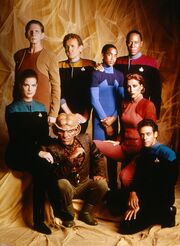
The first season promotional image of the cast of Deep Space Nine
Starring [ ]
- Avery Brooks as Commander / Captain Benjamin Sisko
Also starring [ ]
- Rene Auberjonois as Odo
- Nicole de Boer as Ensign / Lieutenant jg Ezri Dax ( 1998 - 1999 )
- Michael Dorn as Lt. Commander Worf ( 1995 - 1999 )
- Siddig El Fadil as Doctor Bashir
Beginning in 1995, El Fadil was credited as Alexander Siddig and moved between Shimerman and Visitor in the opening credits.
- Terry Farrell as Lieutenant / Lt. Commander Jadzia Dax ( 1993 - 1998 )
- Cirroc Lofton as Jake Sisko
- Colm Meaney as Chief O'Brien
- Armin Shimerman as Quark
- Nana Visitor as Major / Colonel Kira
Special guest stars [ ]
- Steven Berkoff as Hagath
- Rosalind Chao as Keiko O'Brien
- Jeffrey Combs as Weyoun
- Meg Foster as Onaya
- Jonathan Frakes as Thomas Riker / William T. Riker
- Louise Fletcher as Winn Adami
- Salome Jens as the Female Changeling
- Penny Johnson as Kasidy Yates
- Richard Kiley as Gideon Seyetik
- Richard Libertini as Akorem Laan
- Andrea Martin as Ishka
- Bill Mumy as Kellin
- Brock Peters as Joseph Sisko
- Andrew Robinson as Elim Garak
- Tim Russ as Tuvok
- William Sadler as Sloan
- Michael Sarrazin as Trevean
- Wallace Shawn as Grand Nagus Zek
- Kurtwood Smith as Thrax
- Patrick Stewart as Jean-Luc Picard / Locutus of Borg
- Leigh Taylor-Young as Yanas Tigan
- Clarence Williams III as Omet'iklan
Special appearances by [ ]
- Bernie Casey as Calvin Hudson
- James Darren as Vic Fontaine
- Robert Picardo as Lewis Zimmerman / Emergency Medical Holographic program
- Chris Sarandon as Martus Mazur
- Vanessa Williams as Arandis
Recurring characters [ ]
- Cecily Adams and Andrea Martin as Ishka
- Marc Alaimo as Gul Dukat
- Philip Anglim as Vedek Bareil
- Casey Biggs as Damar
- Jeffrey Combs as Liquidator Brunt
- Max Grodénchik as Rom
- Aron Eisenberg as Nog
- Hana Hatae as Molly O'Brien
- J.G. Hertzler as General Martok
- Barry Jenner as Admiral Ross
- David B. Levinson as Broik
- Kenneth Marshall as Michael Eddington
- Chase Masterson as Leeta
- Robert O'Reilly as Chancellor Gowron
- Duncan Regehr as Shakaar
- Andrew J. Robinson as Elim Garak
- Mark Allen Shepherd as Morn
Executive producers [ ]
- Rick Berman – Executive Producer
- Michael Piller – Executive Producer (1993–1995)
- Ira Steven Behr – Executive Producer (1995–1999)
Staff writers [ ]
- Ira Steven Behr , Staff Writer
- Hans Beimler , Staff Writer (1995–1999)
- René Echevarria , Staff Writer ( 1994 –1999)
- Ronald D. Moore , Staff Writer (1994–1999)
- Bradley Thompson , Staff Writer ( 1996 –1999)
- David Weddle , Staff Writer (1996–1999)
- Robert Hewitt Wolfe , Staff Writer (1993– 1997 )
Episode list [ ]
Season 1 [ ].
DS9 Season 1 , 19 episodes:
Season 2 [ ]
DS9 Season 2 , 26 episodes:
Season 3 [ ]
DS9 Season 3 , 26 episodes:
Season 4 [ ]
DS9 Season 4 , 25 episodes:
Season 5 [ ]
DS9 Season 5 , 26 episodes:
Season 6 [ ]
DS9 Season 6 , 26 episodes:
Season 7 [ ]
DS9 Season 7 , 25 episodes:
Related topics [ ]
- DS9 directors
- DS9 performers
- DS9 recurring characters
- DS9 studio models
- DS9 writers
- Character crossover appearances
- Undeveloped DS9 episodes
- Paramount Stage 4
- Paramount Stage 17
- Paramount Stage 18
- Star Trek: Deep Space Nine novels
- Star Trek: Deep Space Nine comics (IDW)
- Star Trek: Deep Space Nine comics (Malibu)
- Star Trek: Deep Space Nine comics (Marvel)
- Star Trek: Deep Space Nine soundtracks
- Star Trek: Deep Space Nine on VHS
- Star Trek: Deep Space Nine on LaserDisc
- Star Trek: Deep Space Nine on DVD
External links [ ]
- List of Star Trek: Deep Space Nine characters at Wikipedia
- Star Trek: Deep Space Nine at Memory Beta , the wiki for licensed Star Trek works
- Star Trek: Deep Space Nine at the Internet Movie Database
- Star Trek: Deep Space Nine at TV.com
- Star Trek: Deep Space Nine episodes at the iTunes Store
- Star Trek: Deep Space Nine at StarTrek.com
- Star Trek: Deep Space Nine at Wikiquote
- 2 Daniels (Crewman)
- 3 Sito Jaxa
Log in or sign up for Rotten Tomatoes
Trouble logging in?
By continuing, you agree to the Privacy Policy and the Terms and Policies , and to receive email from the Fandango Media Brands .
By creating an account, you agree to the Privacy Policy and the Terms and Policies , and to receive email from Rotten Tomatoes and to receive email from the Fandango Media Brands .
By creating an account, you agree to the Privacy Policy and the Terms and Policies , and to receive email from Rotten Tomatoes.
Email not verified
Let's keep in touch.

Sign up for the Rotten Tomatoes newsletter to get weekly updates on:
- Upcoming Movies and TV shows
- Rotten Tomatoes Podcast
- Media News + More
By clicking "Sign Me Up," you are agreeing to receive occasional emails and communications from Fandango Media (Fandango, Vudu, and Rotten Tomatoes) and consenting to Fandango's Privacy Policy and Terms and Policies . Please allow 10 business days for your account to reflect your preferences.
OK, got it!
- What's the Tomatometer®?
- Login/signup
Movies in theaters
- Opening this week
- Top box office
- Coming soon to theaters
- Certified fresh movies
Movies at home
- Fandango at Home
- Prime Video
- Most popular streaming movies
- What to Watch New
Certified fresh picks
- 77% Cuckoo Link to Cuckoo
- 97% Dìdi Link to Dìdi
- 97% Good One Link to Good One
New TV Tonight
- 95% Industry: Season 3
- -- Emily in Paris: Season 4
- -- Bad Monkey: Season 1
- -- Bel-Air: Season 3
- -- Rick and Morty: The Anime: Season 1
- -- Solar Opposites: Season 5
- -- SEAL Team: Season 7
- -- RuPaul's Drag Race Global All Stars: Season 1
- -- Star Wars: Young Jedi Adventures: Season 2
- -- Worst Ex Ever: Season 1
Most Popular TV on RT
- 59% The Umbrella Academy: Season 4
- 81% A Good Girl's Guide to Murder: Season 1
- 78% Star Wars: The Acolyte: Season 1
- 95% Batman: Caped Crusader: Season 1
- 100% Supacell: Season 1
- 77% Lady in the Lake: Season 1
- 78% Mr. Throwback: Season 1
- 100% Women in Blue: Season 1
- 78% Presumed Innocent: Season 1
- Best TV Shows
- Most Popular TV
- TV & Streaming News
Certified fresh pick
- 95% Batman: Caped Crusader: Season 1 Link to Batman: Caped Crusader: Season 1
- All-Time Lists
- Binge Guide
- Comics on TV
- Five Favorite Films
- Video Interviews
- Weekend Box Office
- Weekly Ketchup
- What to Watch
30 Most Popular Movies Right Now: What to Watch In Theaters and Streaming
25 Most Popular TV Shows Right Now: What to Watch on Streaming
What to Watch: In Theaters and On Streaming
Awards Tour
The Freakier Friday Cast on New Music, Filming the Iconic Scream Scene, and More
Weekend Box Office: Deadpool & Wolverine Crosses $1 Billion
- Trending on RT
- Video Game Movies
- Best Movies of 2024
- Re-Release Calendar
- TV Premiere Dates
Season 1 – Star Trek: Deep Space Nine
Where to watch, star trek: deep space nine — season 1.
Watch Star Trek: Deep Space Nine — Season 1 with a subscription on Paramount+, or buy it on Fandango at Home, Prime Video, Apple TV.
What to Know
Deep Space Nine 's first season lays the groundwork for what could be the grittiest Star Trek series yet.
Critics Reviews
Audience reviews, cast & crew.
Avery Brooks
Cmdr. Benjamin Sisko
Rene Auberjonois
Alexander Siddig
Dr. Julian Bashir
Terry Farrell
Lt. Jadzia Dax
Cirroc Lofton
Colm Meaney
Chief Miles O'Brien
More Like This
Season info.

Currently available on 9 streaming services.
Star Trek: Deep Space Nine (1993)
Streaming in:
We checked for updates on 251 streaming services on August 13, 2024 at 12:22:50 AM. Something wrong? Let us know!
Newest Episodes
S7 e26 - what you leave behind (2), s7 e25 - what you leave behind (1), s7 e24 - the dogs of war, star trek: deep space nine - watch online: streaming, buy or rent.
Currently you are able to watch "Star Trek: Deep Space Nine" streaming on Paramount Plus, Paramount Plus Apple TV Channel , Paramount+ Amazon Channel, Paramount+ Roku Premium Channel or for free with ads on Pluto TV. It is also possible to buy "Star Trek: Deep Space Nine" as download on Amazon Video, Apple TV, Fandango At Home, Google Play Movies, Microsoft Store.
At Deep Space Nine, a space station located next to a wormhole in the vicinity of the liberated planet of Bajor, Commander Sisko and crew welcome alien visitors, root out evildoers and solve all types of unexpected problems that come their way.
Videos: Trailers, Teasers, Featurettes

Where does Star Trek: Deep Space Nine rank today? The JustWatch Daily Streaming Charts are calculated by user activity within the last 24 hours. This includes clicking on a streaming offer, adding a title to a watchlist, and marking a title as 'seen'. This includes data from ~1.3 million movie & TV show fans per day.
Star Trek: Deep Space Nine is 697 on the JustWatch Daily Streaming Charts today. The TV show has moved up the charts by 66 places since yesterday. In the United States, it is currently more popular than Life in Pieces but less popular than Not Dead Yet.
Streaming charts last updated: 1:17:11 AM, 08/13/2024
People who liked Star Trek: Deep Space Nine also liked
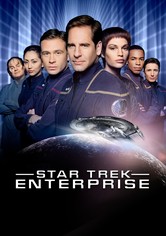
Popular TV shows coming soon
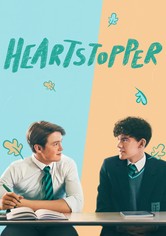
Upcoming Drama TV shows
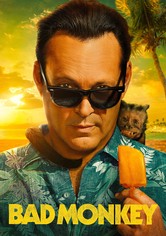
Similar TV shows you can watch for free

Lists featuring Star Trek: Deep Space Nine

Where To Watch Every Star Trek TV Show and Movie in Order
Latest Tweets
- December 2023
- August 2022
- February 2021
- January 2021
Star Trek: Deep Space Nine - Episode Guide - Season 5
Season 5 of Star Trek: Deep Space Nine may be described as the show as its most Next Generation-ish attributes. At least one-quarter of the scripts in DS9 season 5 are “head trip” episodes, and the “Torture O’Brien” trope positively flowers in this run of episodes.
Lots of individual stories could be highlighted here, but of special note is most definitely “Trials and Tribble-ations”, one neat time-travel story about the DS9 crew traveling backward in time to the days of the NCC-1701, where/when they spend much of the time trying to avoid Kirk while trying to prevent his “untimely” assassination.
1. Apocalypse Rising – Klingons! Lots of Klingons! Sisko, Odo and O’Brien disguised as Klingons! These three and Worf infiltrating a drunken Klingon bash! The return of Gawran, one of the baddest of Klingon badasses, bringing more badassery! Great stuff if you dig on Klingons! ****
2. The Ship – While on an away mission, Sisko, Dax, Worf, O’Brien and a neo-Red Shirt witness the crashing of a Jem’Hadar warship whose occupants had been killed in gnarly fashion. The DS9’ers take this as a signal to salvage the ship and get out, but the arrival of a Vorta complicates matters… ***
3. Looking for par'Mach in All the Wrong Places – All right: A Star Trek episode based primarily in romantic relationships that isn’t cloyingly cheesy. Grilka, Quark’s Klingon wife of “the House of Quark”, comes to the station for Quark’s assistance with an accounting issue. Worf begins to get the hots for Grilka, only to become the magnet of Dax’s affections. O, and in a subplot, O’Brien, Keiko and Kira kinda sorta have some three-way tension going on … ****
4. Nor the Battle to the Strong – While returning from a medical conference, Bashir and Jake Sisko receive a distress call from a Federation colony. Soon they’re embroiled in a full-on attack by Klingon forces, and Jake’s bravery is tested mightily. ***
5. The Assignment – This one’s a combination of ST’s Disembodied Alien, Head trip for O’Brien and Torment O’Brien themes: Keiko returns from a visit to Bajor, promptly telling her husband that she’s actually a (yep) disembodied alien. ***
6. Trials and Tribble-ations – Ah, yes, one of the crowning jewels of Star Trek Deep Space Nine and worthy of inclusion on nearly any Top 10 or Top 20 Star Trek Episodes-type listicle. Six of the DS9 bridge crew chase a Klingon criminal into the past, when Deep Space 9 was smaller and was visited by the crew under command of one James T. Kirk… *****
7. Let He Who Is Without Sin ... – The way Riker always touted the virtues of Risa on ST:TNG, you’d think things would go a lot more smoothly when Federation types visit the so-called “pleasure planet.” But nooooooo: Worf and Dax attempt to get their kink on but instead discover a longshot insurgency attempt. Some funny stuff with Bashir and Quark takes an unfortunate back seat. ***
8. Things Past – Head trips all around! Bashir finds Sisko, Odo, Garak and Dax aboard a returned shuttlecraft, but comatose. Meanwhile, the four believe themselves to be Bajoran prisoners in a time approximately seven years past – and only Odo remembers the truth… ***
9. The Ascent – Odo and Quark crash land a shuttlecraft (imagine that) on an uninhabited planet and must survive without most or their high technology. In a subplot, Jake and Nog move into an apartment on another side of the station. Pretty good character-y stuff on the parts of several of Deep Space Nine’s ever-burgeoning cast. ***
10. Rapture – The story of Sisko-as-Emissary/Prophet continues, as the Captain experiences visions. Sadly, no reference to or sample of Blondie’s seminal tune is included. ***
11. The Darkness and the Light – A classic “Kira’s past comes back to haunt her” episode, as her former resistance comrades are murdered one by one… ***
12. The Begotten – In a surprisingly touching episode, Quark acquires a baby Changeling which Quark cares for until its inevitable ST-style ending. The subplot has Kira giving birth to the O’briens’ baby. ****
13. For the Uniform – Michael Eddington, former Starfleet officer gone rogue with the Maquis, returns to the station to unleash his “cascade virus” on multiple computer systems. Also to bog down an entire episode with a critical mass of plot-detail minutiae. **
14. In Purgatory’s Shadow – The shuttlecraft of Worf and Garak (Star Trek Guide loves this episode already) is taken by Jem’Hadar, who put them into a prison camp along with … if the off-chance you haven’t seen it, let’s just say a key member of the bridge crew hasn’t been him-/herself for a while. It all ends with the moment viewers have awaited for some time, namely the invasion of Dominion ships into the quadrant and Federation/Cardassian space. And to be continued. ***
15. By Inferno’s Light – A key episode in DS9 continuity, as many of the concepts and characters who drive the series for the next couple of seasons are introduced here. Most prominent among these is of course Cardassia’s alignment with the Dominion. ***
16. Doctor Bashir, I Presume? – Great title, but rather irrelevant to the story. Starfleet is set to reconstruct the Emergency Medical Hologram program based on Dr. Zimmerman and gets to work in replicating Bashir for the job. Yet he has strange misgivings about the “honor.” ***
17. A Simple Investigation – Odo gets to live the space opera romance story arc in a single episode with a beguiling woman who is not as she seems ‘yadda yadda’ never heard from again. **
18. Business as Usual – Now *this* is more like it. Quark’s cousin Gaila promises to help Quark recoup some recent losses in bad investments if Quark helps move some armaments on the black market. ***
19. Ties of Blood and Water – Ghemor, a hero to Bajorans during the war whom Kira hoes will lead a resistance on Cardassia against Gul Dukat’s new government, comes aboard the station to die. And damn does he drag it out. Not even Dukat and Weyhoun can pull this one out of the doldrums. **
20. Ferengi Love Songs – Still on a run of bad luck, Quark heads home to interact with his mother and the Grand Nagus. On the station, crap about Rom and Leeta’s relationship dominates the “action.” **
21. Soldiers of the Empire – Back to the Klingons! General Martok recruits Worf to join him on a quest for a Jem’Hadar ship which has captured 35 Klingons. Dax tags along, and Worf restores some well-missed élan for battle among Martok’s crew. ***
22. Children of Time – Temporal paradox time for Sisko, Odo, Kira, Dax and (naturally) O’Brien, as they meet their apparent descendants after the Defiant crash-lands two centuries ago/two days henceforth. ***
23. Blaze of Glory – The Maquis are reportedly ready to engage in what is essentially a suicide mission against Cardassia, and Sisko must scheme a way out of the attack which he reckons would immediately lead to between the Federation and Cardassia/the Dominion. The subplot traces Nog’s relative success in his position as a Starfleet security (why, dude?) trainee. ***
24. Empok Nor – O’Brien and Garak lead an away team which includes a handful of Red Shirts to the abandoned titular space station. Of course, it ain’t as abandoned as everyone except the viewers would figure. ***
25. In the Cards – What’s the connection between a 325-year-old baseball card, the Jem’Hadar and one man’s quest for immortality? Check out “Jake Sisko vs. the Barter System” – I mean, “In the Cards” to find out. ****
26. Call to Arms – The inevitable comes to pass: Too many Dominion forces exist in Federation space, too many Federation-allied ships have “disappeared” and the danger of a greater invasion is too real. Sisko ultimately pulls the trigger with a preemptive tactic that causes a war and puts DS9 on the front line… ***
Star Trek: Deep Space Nine

- Avery Brooks as Cmdr./Capt. Benjamin Sisko
- Rene Auberjonois as Odo
- Nana Visitor as Maj./Col. Kira Nerys
- Alexander Siddig as Dr. Julian Bashir
- Colm Meaney as Chief Miles O'Brien
- Armin Shimerman as Quark
- Terry Farrell as Lt. Jadzia Dax [ 1-6 ]
- Cirroc Lofton as Jake Sisko
- Michael Dorn as Lt. Cmdr. Worf [ 4-7 ]
- Nicole deBoer as Lt. Ezri Dax [ 7 ]
Mid-Atlantic Nostalgia Convention, Sep 7 - 9, 2023, Hunt Valley, MD

The Definitive Voice of Entertainment News
Subscribe for full access to The Hollywood Reporter
site categories
‘star trek: deep space nine’ — the 20 greatest episodes.
We boldly go — and revisit the top episodes from 'Deep Space Nine.'
By Aaron Couch , Graeme McMillan September 22, 2016 6:00am
- Share on Facebook
- Share to Flipboard
- Send an Email
- Show additional share options
- Share on Reddit
- Post a Comment
- Share on Whats App
- Share on Pinterest
- Share on LinkedIn
- Print the Article
- Share on Tumblr

Though Deep Space Nine was the fourth Star Trek series to hit the airwaves, it is number one in the hearts of many Trekkies .
The series was grittier and more serialized than any Trek that came before. Over seven seasons and 176 episodes, fans were delighted by the work of stars Avery Brooks ( Sisko ), Rene Auberjonois ( Odo ), Terry Farrell ( Dax ) Cirroc Lofton (Jake Sisko ) Colm Meaney (O'Brien) Armin Shimerman (Quark), Alexander Siddig ( Bashir ), Nana Visitor (Kira) Michael Dorn ( Worf ) and Nicole de Boerwhich .
To mark the 50th anniversary of Star Trek this month, The Hollywood Reporter counted down the top 100 episodes of Star Trek across all six TV series. Every day through Friday, we're breaking that list down even further — ranking the episodes by individual series.
Here, you'll find the cast and crew of DS9 sharing what makes these episodes among the best of what they did from 1993-99. For more, check out the top episodes from the original series and Next Generation .
Related Stories
'star trek': 100 greatest episodes, "improbable cause".
A windy mystery featuring poisons, explosions and interspecies intrigue, Odo attemps to uncovery who is behind a plot to kill Garak , only to learn the Cardassian merchant knows more than he is saying. Many in the DS9 cast of characters are outsiders, and Garek is no different, with the episode exploring his exile and desire to return to the Cardassian fold, no matter the consequences.
"Necessary Evil"
For anyone still wondering what a departure Deep Space Nine was from Next Generation , those questions were thrown out the window by the conclusion of this murder mystery, which revealed one of the station's beloved characters isn't the spotless type you'd expect from the Enterprise-D crew.
"Little Green Men"
Quark, Rom, and Nog are headed to take the younger Ferengi to Starfleet Academy, when an accident sends them back to 1940s Earth, where they end up being responsible for the famous UFO sighting at Roswell. Though Quark has dreams of staying in the 20th century and using the superior technology of their shuttle to set up a business empire like none other, he doesn't get his way in the end.
"Trials and Tribble-ations"
Doubtlessly, there are those who sought a more serious way to mark Star Trek 's 30th anniversary, but "Trials" was a celebration in the most literal sense: a hilarious episode that inserted DS9 's crew in the background of a fan-favorite installment of the original series, gently and affectionately poking fun at the design and attitude of the show as-was while reminding everyone who they loved it so.
Take Me Out To The Holosuite
In the midst of the show's hopelessness, this series is a necessary breath of fresh air as the DS9 crew finds itself having to defend its honor against a group of arrogant Vulcans by … playing baseball, of all things. As if to underscore the contrary nature of the series as a whole, things don't go as well as they might have for the crew of the Enterprise, but there seems something fitting about that, somehow. Pay particular attention for Max Grodenchik's performance as the clumsy Rom; the actor was such a good baseball player that he had to play left-handed to come across as suitably inept.
"The Siege of AR-558"
How bad do things get during the Dominion War? Everything you need to know can be found in this brutal episode, which kills off multiple Starfleet crew — including Lost in Space 's Bill Mumy — and maims one of the show's regular characters in the process. While earlier Star Trek series had reveled in the standalone nature of each episode, the Dominion War storyline in DS9 reveled in the slow burn, meaning that the dramatic events in this episode — and the fallout that followed — had even more impact than fans might have expected at the time.
"It's Only a Paper Moon"
A quasi-sequel to "The Siege of AR-558," this episode didn't just deal with the post-traumatic stress suffered by one of the survivors of the interplanetary siege in the earlier episode, it advances the existence of one of the show's stranger recurring characters: the self-aware hologram and quasi Vegas lounge singer Vic Fontaine (James Darren) in the process. If ever there was an episode that displays the depth and breath of DS9 's varied ambitions, it's this one; touching, challenging and amusing all at the same time.
"Once More Unto the Breach"
Klingon Kor (John Colicos ) is growing old and senile, and asks Worf for one last chance to die in battle. Worf uses his sway to get him on a ship, and though he initially he is humiliated, he eventually gets his warrior's death.
"I liked the honor and loyalty and black and whiteness of Worf ," says Michael Dorn , who rates the episode in his top two for DS9 . "Even though he may chose different things, you're going to do the honorable thing. Even if the honorable thing doesn't appear honorable at first."
"Inquisition"
By the time this episode aired, episodes where one of the crew is suspected of being a traitor were nothing new — The Next Generation had even turned Geordi into a brainwashed would-be assassin at one point — but mixing that idea with the wartime paranoia that had utterly infused DS9 by this point proved a perfectly potent combination, especially when the final twist in the tale is something that no-one saw coming. (We won't spoil it for anyone who hasn't seen the episode yet, but 2013's Star Trek Into Darkness has some roots in this episode, surprisingly enough.)

"Past Tense, Parts I & II"
As everyone who's ever read, watched or lived (Hey, it's not impossible ) a time travel story knows by heart, changing the past is a very bad idea and definitely shouldn't be done — so what happens when some of the DS9 crew end up trapped on Earth, three centuries before they were born, and watch one of the most important historical figures they know of die right in front of them? Factor in commentary on then-contemporary issues about how society treats the homeless and what "Past Tense" offers is classic Trek , even when it's gleefully contradicting and ignoring genre tropes. Think of it as the anti-"City on the Edge of Forever."
"Soldiers of the Empire"
The LeVar Burton-directed episode sees Martok (J. G. Hertzler ) enlist Worf (Michael Dorn ) to find a missing Klinong vessel. When Martok is too afraid to act in the face of the enemy, Worf reluctantly challenges him for command of his ship, eventually letting him win the fight after realizing the general had overcome his fear.
Dorn , who spent more time than anyone playing a Klingon , says acting in an episode that takes place almost entirely on a Klingon ship gave him new insights into his character that even he didn't previously have.
"That was when it first started to hit me how Shakespearean the Klingons were," Dorn says of the episode. "It really spoke to me about who the Klingons really were."
"What You Leave Behind"
The finale of Deep Space Nine might have struggled to meet the challenge of living up to seven years' worth of teases of the mythical nature of the existential Prophets (Gods? Aliens? Both?) and their connection to the show's lead characters and closing out the multiple running storylines, but it doesn't matter: everything is done with such intensity and passion that any and all mistakes are forgiven, especially in light of some pitch-perfect conclusions for many of the show's long serving characters. ( Garak , we're looking at you.) Simultaneously downbeat and optimistic in its refusal to bring the story to an end, there's something effortlessly fitting about the way that Trek 's most challenging incarnation draws to a close.
"A Time to Stand"/"Rocks and Shoals"/"Sons and Daughters"/"Behind the Lines"/"Favor the Bold"/"Sacrifice of Angels"
The fifth season finale of Deep Space Nine hadn't just broken the utopian pacifism of the franchise as a whole, it had broken the very concept of the series by kicking Starfleet off Deep Space Nine and placing the station into the hands of the Dominion. What followed broke new ground for Trek as a whole, as the franchise moved into a serialized format for the first time ever outside of the two-parters fans loved, with a six-episode arc showing how the good guys got to go home. Although they achieve their goal — you can only break the concept of your show for so long, after all — success comes with a cost, and events in this arc set up the remainder of the series and changes DS9 as a show going forward. An ambitious victory for showrunner Ira Steven Behr and his team.
"A wonderful actor, Harris Yulin , and I, were given the episode 'Duet during the first season of Deep Space Nine ," recalls Nana Visitor, who played Kira Nerys for seve seasons. "What I knew going in was that it was a 'bottle' show, meant to help make up some of the money that was spent on the special effects-laden pilot. Two characters, few effects. It felt like it was going to be disastrous the whole time we were shooting."
The episode, which deals with dark material such as cowardice, prejudice and even genocide, went on to be be a hallmark of the first season. But Visitor didn't know at the time it would turn out so well.
"Everything felt like a struggle," she admits. "I even struggled with my own sense of ethics with my character. I struggled with Harris. I struggled with being on mostly one claustrophobic set sixteen hours a day, watching Harris struggle with one of the heaviest makeup the show did. When I saw the show, I was amazed. The writing was beautiful, true to life's shades of grey when you delve beneath the surface, which the writer's certainly did. Harris was heartbreaking, and going through the filming of that show left me with a phrase that is still in my brain and continues to humble me, 'I don't know.' "
"Call to Arms"
After three years of prelude, the series closed out its fifth season by doing the one thing that Star Trek wasn't supposed to, as a franchise: declaring war, and taking Trek away from its pacifist outlook and into the great unknown for the first time in decades. Co-written by showrunner Ira Steven Behr and the dependable Robert Hewitt Wolfe, this episode underscores DS9 as the series that betrayed the very ideals that make Star Trek what it is — and strengthens the franchise as a whole as a result.
"Homefront" and "Paradise Lost"
With impressive understatement, the two-parter at the center of the show's fourth season — and the entire series as a whole — quietly drives home the scale of the danger facing humanity as Sisko finds himself facing both the Dominion and Federation as a result of the paranoia being sown by the shape-changing Founders. When the enemy can look like anyone they want, who can be trusted? (One answer: Sisko's father, played by Trek veteran Brock Peters; clearly, he's making up for his untrustworthy Star Trek VI character, who was working against Kirk and co. back in the day.)
[youtube https://www.youtube.com/watch?v=dJ33e9BK9aU]
The pilot for Deep Space Nine is considered the strongest in Trek history — with it making the bold move of beginning in the middle of the action at the battle of Wolf 359, where Sisko lost his wife at the hands of Locutus of Borg. Director David Carson had worked on TNG , and notes DS9 was "completely and daringly different" from earlier Trek .
"Creators, Michael Piller and Rick Berman pushed the Star Trek universe into areas it had never been before and at the same time stayed true to the overall concept so that the immense fan base would be satisfied with what we did," says Carson. "The most significant change — which changed everything — was to set the series in a static space station guarding a wormhole, not constantly on the move, going where no one had been before. As a consequence, the stories became darker and less episodic, charged with more emotion and more closely analogous to the social problems of our age."
"The Visitor"
[youtube https://www.youtube.com/watch?v=ozq3_cWia3s]
Guest star Tony Todd gave one of the greatest Trek performances of all time as an aging Jake Sisko , who dedicates his life to trying to save his father after an accident sends him rippling through time.
"It was like lighting in a bottle," recalls Todd. "I first appeared as the lost Klingon brother of Worf in Next Generation . By the time the 'The Visitor,' came along, my Aunt Clara, who raised me, had recently passed. Totally inconsolable, out of the blue, this fabulous script came along, and accepting her voice to get up and move forward, I dived into the task at hand."
Todd played Jake throughout the decades, having extraordinary chemistry with Avery Brooks as a son consumed with grief, and who eventually grows older than his own parent. Todd still considers it the role of a lifetime.
"Without trepidation, I accepted David Livingston’s direction like none other before or since, and turned in a performance like none other before. Totally connected, the tremendous cast of DS9 accepted my channeling and allowed me to embrace the virtues of Star Trek ," he says.
"Far Beyond the Stars"
[youtube https://www.youtube.com/watch?v=a0fk4H2DSM0]Avery Brooks directed the stirring episode, which sees Sisko have a vision of himself living as a sci-fi writer in the 1950s , where he deals with racism on a daily basis.
"It is the very best of Star Trek, if not some of the very best of science fiction in general," says Armin Shimerman , who played Quark for seven seasons. "Even though that was a problem in the 1950s and Star Trek takes place in 24th century, one can imagine, although one hopes, it isn't going to be that way, that racism is still a problem."
The episode culminates with one of Brooks' finest monologues , with his character Benny Russell breaking down after facing discrimination his whole life. Shimerman recalls standing to the side while Brooks delivered his monologue , calling it "a great tribute to Avery that he was able to give a sterling performance while he was shouldering the responsibilities of being a director."
"In the Pale Moonlight"
[youtube https://www.youtube.com/watch?v=K-YyL7X4CWw]If DS9 was the Star Trek series that asked questions the other series shied away from — and it was, on a regular basis — this is the archetypal episode that shows how fearlessly the show pushes the envelope. In the midst of war with the Dominion, Sisko betrays the ideals of Starfleet for the greater good and then dares the audience to fault him for his decision. Avery Brooks' brittle, angry performance anchors an episode that underscores the cost the war is having on his character, and the series as a whole. Who knew Star Trek could feel this dark, or conflicted?
THR Newsletters
Sign up for THR news straight to your inbox every day
More from The Hollywood Reporter
Bill camp, merritt wever board hbo’s ‘gilded age’ for season 3, how nikki glaser became the new queen of comedy, peacock’s ‘hysteria’ teaser brings demons to the suburbs, kit harington says “mistakes were made” making a “rushed” ‘game of thrones’ season 8, where ‘rhonj’ left things in season 14’s post- finale special, alan cumming insists, “i act my socks off in ‘the traitors’”’.
The 10 Best Episodes of 'Star Trek: Deep Space Nine'

Your changes have been saved
Email is sent
Email has already been sent
Please verify your email address.
You’ve reached your account maximum for followed topics.
'Batman: Caped Crusader' Gives Harley Quinn an Even Better Origin Story
‘batman: caped crusader’s best episode is also its most heartbreaking, let's talk about 'lady in the lake' episode 5's gruesome ending.
If there is such a thing as a “pessimistic” version of Star Trek , that radically hopeful cornerstone of 20th century science fiction, then Star Trek: Deep Space Nine is as close as it gets. Premiering in 1993, Deep Space Nine quickly charted a course unique to the franchise, from the way it told its stories – in Season (and series) long story arcs – to what those stories were about -- the politically tangled, emotionally complex territory of war and occupation. This was terrain that its progenitors, Star Trek: The Original Series , and Star Trek: The Next Generation , had only glimpsed. The rosy vision of the future at the core of Star Trek -- with its improbably well-adjusted human race and largely harmonious universe – was long overdue for reassessment, and Deep Space Nine did just that, lingering in the morally opaque margins of Gene Roddenberry’s utopian fantasy, but doing so without losing the essence of what made Star Trek so beloved.
In fact, Deep Space Nine broadened Star Trek ’s central conceit by consciously turning away from it, and thereby making it more relatable. We’re not perfect beings, the show reminds us (as if we needed it), and the road to paradise is rougher than we imagined -- but we’re still trudging along, and the struggle towards perfection is no less noble than its assumption. That struggle, it must also be said, makes for more dramatically interesting TV, and it’s at the heart of what makes Deep Space Nine the best Star Trek show ever made.
Not convinced? Here are ten classic episodes to change your mind:
RELATED: Ronald D. Moore Shares Some Great Stories About Writing 'Star Trek: THe Next Generation' and 'DS9'
"In the Pale Moonlight" (Season 6, Episode 19)
How much are you willing to sacrifice when your back is against the wall? That’s not a question often asked in Star Trek , which typically presents us with protagonists who have the luxury of the moral high ground – people who have nothing to lose by doing the right thing. But when those rosy circumstances change, when the choice is between our principles and our continued survival – what choice do we make? That’s the question In the Pale Moonlight asks, in not only one of the best episodes of Star Trek ever made, but in one of the most gloriously bravura hours of television ever filmed.
If you’re wondering what all that “ Deep Space Nine is the morally gray version of Star Trek ” fuss is about, go watch this episode and get vaporized.
"Far Beyond the Stars" (Season 6, Episode 13)
Far Beyond the Stars finds Captain Sisko ( Avery Brooks ) caught in a time-traveling reverie: he’s stuck in 1953, living the life of a science fiction writer named Benny Russell, and totally unaware of having ever been the captain of a space station in the far future. As if that weren’t enough, Russell must endure racism both blatant and subtle -- in the form of police brutality and workplace discrimination – all while being strangely drawn to write a story about a “fictional” space station called Deep Space Nine.
Star Trek had taken on racism before, but it always felt like something of an academic exercise -- the work of writers fundamentally opposed to racial prejudice while also being safely insulated from its real-world horrors. Episodes like the original series’ Let That Be Your Last Battlefield – in which an alien race segregates its members based on the pattern of color on their faces -- point out the absurdity of racism without actually engaging with it, treating it like some logical fallacy to be disproven, or a primitive “idea” long since dispensed with, rather than something still out there, deeply engrained in human society.
That’s what makes Far Beyond the Stars so affecting: it doesn’t let its audience off the hook—it’s addressing itself to us . And by doing so, it creates the most vital statement on race that Star Trek has ever attempted.
"The Visitor" (Season 4, Episode 3)
In another victory for real live humans, Deep Space Nine showed us a commanding officer grappling not just with grand existential concerns, like obeying the Prime Directive or avoiding a war with the Romulans, but with the decidedly more earthbound demands of parenthood. And indeed, Captain Sisko’s relationship with his son Jake ( Cirroc Lofton ) is the heart and soul of DS9 -- the warmth between the two is unflagging and tender (and real -- actors Avery Brooks and Cirroc Lofton have remained close) so it’s no surprise that Deep Space Nine ’s most emotionally powerful hour would showcase the love, and heartbreaking devotion, of these two characters for each other.
There are precious few evocations of familial love in popular science fiction -- much less the bond between a father and son -- but The Visitor showcases both with unbelievable beauty and grace, not once misstepping into melodrama.
I don’t know if it’s the best episode of Star Trek ever made, but it’s certainly the only one to ever make me cry, and I suspect I’m not alone.
"Duet" (Season 1, Episode 19)
Deep Space Nine gets a lot of flak for its early seasons, and not without reason – in the years before it moved toward grand narrative arcs and incisive character studies, it struggled to find its footing, lost in the shadow of its wildly popular predecessor, Star Trek: The Next Generation, and attempting (largely unsuccessfully) to emulate that show’s episodic structure. But season one’s Duet was a promising hint of things to come. The episode is essentially a stage play -- simply, but powerfully, told as a series of conversations between occupation survivor Kira Nerys ( Nana Visitor ) and her Cardassian prisoner, Marritza ( Harris Yulin ) a man who may in fact be one of the worst war criminals in Bajoran history.
The stage is thus set for a simple morality tale, in classic Star Trek style, in which good guys wag their fingers at bad guys, maybe even teaching them a lesson in the process. But DS9 , true to the murky ethical view that would come to define its universe, eschews simple answers. Instead, it never stops asking questions -- even when the finger points squarely back at us.
"Who Mourns for Morn?" (Season 6, Episode 12)
As dark as Deep Space Nine could sometimes be, it could also be fun (and funny) -- particularly in its bottle episodes. Who Mourns for Morn? probably won’t place in many top ten lists, but it’s always been a favorite of mine, not just for its light-hearted tone, but for the way it highlights DS9 ’s outstanding commitment to all of its characters. And I do mean all of them. Not only did the show thoughtfully flesh out the stories of its supporting cast over its seven-year run, it even made time for its extras -- including one who never uttered a single line.
That would be Morn ( Mark Allen Shepherd ), of course -- the mute, vaguely porcine humanoid perpetually parked at Deep Space Nine's bar. Morn’s death triggers the action in this bit of frivolity from season six, sending Quark ( Armin Shimerman ) on a wild goose chase and giving us all more insight into everyone’s favorite interstellar barfly – and his digestive system -- than we ever thought we’d need.
"What You Leave Behind" (Season 7, Episode 25)
A barn-burning series capper, What You Leave Behind -- unlike many other episodes on this list -- can’t truly be appreciated without first familiarizing yourself with everything that came before, a testament to how profoundly interwoven Deep Space Nine ’s stories had become by the time of its finale. But once you’re prepared, get ready for a whopper of an ending: the culmination of the Dominion War in a space battle as epic as anything in Trek history, the final act of Cardassian Damar's ( Casey Biggs ) rocky journey to apotheosis (the greatest character arc in all of Star Trek ) and – by the way – the last goodbye to all of our friends on DS9 .
Though some choices proved controversial (particularly the culturally-fraught coda of Sisko’s storyline) most hit the target, and Deep Space Nine departed as it lived: bold, complicated, and just a bit sad.
"Homefront/Paradise Lost" (Season 4, Episodes 11 & 12)
How do you identify, let alone defeat, an enemy who can literally look like anyone? Such was the dilemma the Federation faced in its series-long conflict with the shape-shifting Changelings, a foe who brought new meaning to the phrase “hiding in plain sight.” Aside from a few episodes, DS9 only occasionally focused on the psychological havoc a few well-positioned shape-shifters might cause. The most notable exception being season four two-parter Homefront and Paradise Lost .
These episodes unleash the Changelings on an unsuspecting Earth -- that holiest of holies in the Star Trek universe -- and by doing so reveal that a carefully concocted paranoia might be more of a threat to freedom and democracy than even the most fearsome army – fairly prescient, wouldn’t you say?
"The Sound of Her Voice" (Season 6, Episode 25)
Though Deep Space Nine threw the Star Trek universe into existential crisis, in ways both subtle and profound, it was also – somewhat surprisingly -- the most heartfelt of any iteration of Trek before or since, as compassionate in its portrayal of human tenderness as it was unflinching in its exploration of human frailties. There’s plenty proof of that on display in The Sound of Her Voice , another bottle episode that, like Duet above, draws its considerable emotional power entirely from conversations between characters.
It’s also helped along by virtue of one high concept twist – best not revealed here – that reminds us that the distance to each other is as close as the sound of our voices -- and farther than the farthest star.
"Take Me Out to the Holosuite" (Season 7, Episode 4)
Following a challenge by a visiting captain, the DS9 regulars find themselves drawn into a baseball game with a team of “superior” Vulcans. Our ragtag home team (the “Niners”) are – on paper at least -- no match for their opponents. Can Sisko’s crew rise to the occasion and defeat their pointy-eared rivals? Will they discover there’s more to life than just winning? Will Quark catch a pop-fly with his ear? Stay tuned, holographic sports fans!
Yes, Take Me Out to the Holosuite is essentially The Bad News Bears meets Deep Space Nine . And, frankly, that’s just fine. As it closed in on the end of its run, the show had more than earned this kind of cheerful frivolity, which gave us some wonderful, funny character moments with our beloved cast, and also provided a much-needed respite from the monumental goings-on in the show’s final season.
Given all that, I’d call Take Me Out to the Holosuite a homerun.
"Trials and Tribble-ations" (Season 5, Episode 6)
Star Trek: The Original Series and Deep Space Nine are such polar opposites that it’s strange to be reminded that they both inhabit the same narrative universe, much less the same aesthetic one – Captain Kirk’s ( William Shatner ) moralizing soliloquies would feel as out of place aboard DS9 as the original series’ boxy Playmobil sets. It’s those discrepancies that make for a campy good time in season five’s Trials and Tribble-ations , which finds the time-traveling DS9 crew aboard the USS Enterprise way back in the Technicolor age of the 23rd century.
The plot of this episode is barely there, existing only to get our cast inserted into the original series (and interacting with the original cast) -- but that’s hardly the point. Trials and Tribble-ations was made to be pure fan service (it aired during the original series’ 30th anniversary) and in that, it succeeds brilliantly. The costumes, sets, and special effects all blend together seamlessly to create a loving ode to the show that started it all – and it’s still the greatest cross-over in all of Trek history.
- TV Features
Screen Rant
Why terry farrell's dax left star trek deep space 9 after season 6.

Your changes have been saved
Email is sent
Email has already been sent
Please verify your email address.
You’ve reached your account maximum for followed topics.
Star Trek: Deep Space 9’s 20 Best Episodes Ranked
Star trek: killing off jadzia dax was ds9's biggest mistake, 10 cruelest deaths in star trek history.
- Lt. Commander Jadzia Dax's departure from DS9 was permanent and shocking, resulting from behind-the-scenes issues.
- Terry Farrell's decision to leave stemmed from fatigue and a desire for a reduced role in the final season.
- Despite her departure, Farrell expressed interest in returning to the Star Trek franchise in the future.
Debuting in Star Trek: Deep Space Nine 's first episode Emissary, Lt.. Commander Jadzia Dax was one of the show's most popular characters, so why did she leave? The Science Officer, ally of Captain Sisko (Avery Brooks) and eventual romantic partner to Worf (Michael Dorn) was played by Terry Farrell for 5 years before her shocking departure at the end of season 6. Her death sent shockwaves through Star Trek fan circles.
Deep Space Nine 's era in the Star Trek timeline was one marked by war, and death was a frequent part of the long-running storylines. Some of the most prominent deaths of DS9 cast members - like that of Miles O'Brien and Benjamin Sisko - can be put down to time travel shenanigans, but Jadzia Dax's death was permanent and came thanks to behind-the-scenes issues.
Deep Space Nine is one of the most acclaimed Star Trek shows, thanks to its mature direction, and many of its best episodes reflect this darker tone.
Why Did Terry Farrell Leave Deep Space Nine?
The real reason why Terry Farrell left Star Trek: DS9 is the subject of some debate . In 2011, Farrell told Star Trek.com that her contract came to an end, discussing her immediate casting in Paramount's Becker:
My contract had ended, so I didn’t feel like I left the show. I felt like my contract had ended and there wasn’t a negotiation (for another year). It was ironic that Becker also let me go, as a person, I was really fortunate to have the experience of working on a half-hour show as well. That also took me a few years to get in the trenches and really wrap my brain around where I was at. The first year was terribly difficult because I was so used to being a hero. It’s very hard, then, to go be on a sitcom where your character is so neurotic and can’t get anything right. I had no break in between — I died one day (on DS9) and the very next day I tested (for Becker) for the same executives at Paramount. It was a lot.
She told Star Trek.com in the same 2011 interview that her decision to request a lessened role was linked to self-care:
I did not want to die. I would have been so happy if they just would have let me be a recurring (character) the final season, so I didn’t have to be in every episode. I was just really tired. I was tired of waking up at four in the morning. I was tired of all the minutiae. I’m sure a lot of the other actors feel this way, too. When you’re number five (on the call sheet), you’re waiting for that schedule to arrive and it becomes frustrating. You want to feel like you have your life again, and I’d definitely put my life on hold because I didn’t know how to balance a schedule constantly changing all the time. It was really hard for me.
As recounted in Star Trek oral history, The Fifty-Year Mission: The Next 25 Years, Farrell wanted to drop her role down to a recurring character, meaning she'd appear in fewer episodes for the seventh and final season of DS9 . Farrell revealed that she felt the producers were trying " to bully me into saying yes [to signing onto a full season 7 schedule]. "
The problems with my leaving were with Rick Berman. In my opinion, he’s just very misogynistic… Basically he was trying to bully me into saying yes [to signing a new contract]. Rick said I was hardballing him and I said ‘I’m not. I just want to have a conversation. You’re giving me a take-it-or-leave-it offer, and I’m not okay with that.’ So, finally I did have a conversation with him and asked to cut down my number of episodes or just let me out.
DS9 executive producer Rick Berman refuted her claims that he was behind her dismissal in The Fifty-Year Mission, and offered context on why the decision was made to kill her off:
To say that this woman was let go is absolutely ridiculous. She was not fired. She requested to not be in all the episodes... to be a recurring character. The studio basically said "no way"... She's a regular character, and she does all twenty-six shows or nothing... She ended up departing. It certainly was not my choice. It was the loss of a character, and it was difficult for us.
Deep Space Nine showrunner, Ira Steven Behr subsequently revealed his frustration at how events played out: "Let me put it this way, if I had known what was going on, I would have stopped it."
Star Trek: Deep Space Nine killed off Jadzia Dax in season 6, the unfortunate result of backstage tensions between Terry Farrell and Paramount.
How Star Trek DS9 Killed Jadzia Dax
Star Trek has never shied away from killing characters for effect, but main characters tend to avoid the most final of fates. Notable exceptions, of course, include the likes of Tasha Yar on The Next Generation , Hugh in Picard , and Trip Tucker in Enterprise . Captain Kirk himself has died, more than once, and Spock temporarily crossed the veil in Star Trek II , before dying for real in Star Trek: Beyond .
Jadzia Dax joined that grim list of crew members at the end of Star Trek: Deep Space Nine season 6, in a shocking twist that left an indelible scar on the fandom. She was murdered during "Tears of the Prophets," by Gul Dukat (Marc Alaimo), as the most prominent casualty of the Dominion War , cementing his status as the show's most despicable villain. It came just as she received the news she could conceive children with her partner Worf (Michael Dorn), adding a particularly cruel note.
After her mortal wounding in the Bajoran Shrine, Dr. Bashir (Alexander Siddig) did manage to save the Dax symbiote inside her, but he was unable to save Jadzia. Ezri Tigan became Dax's new host, who joined for DS9 's final season, played by Nicole de Boer.
Star Trek may depict a utopian future, but death still catches up with even its most beloved characters. Here are 10 of Star Trek's cruelest deaths.
Terry Farrell Revealed She Would Like To Return To Star Trek
Despite the seemingly acrimonious nature of her departure from DS9 , Farrell did later express her enthusiasm at the idea of returning to the Star Trek franchise. At the 2022 Star Trek Las Vegas convention, she pointed out that death in Star Trek didn't necessarily have to be final:
I was actually thinking about how Spock died. Didn’t he melt, basically? He saved everyone’s life. And then he just came back… and there he was. And Kirk kind of went, “Oh, there he is.” And everyone nodded and said, “Yes, he’s back!” I want that moment for me… Exactly how you bring her back, it’s no big fucking deal.
Since her departure from DS9 , and after retiring in 2002, Farrell appeared in fan project Renegades , as a thinly-veiled clone of Jadzia Dax, called Jada. The fan film and subsequent series were forced to remove all Star Trek branding after the introduction of official fan production guidelines. She is also now a co-host on Star Trek rewatch podcast the Delta Flyers alongside former DS9 co-star Armin Shimerman.
Star Trek: Deep Space Nine
Not available
Star Trek: Deep Space Nine, also known as DS9, is the fourth series in the long-running Sci-Fi franchise, Star Trek. DS9 was created by Rick Berman and Michael Piller, and stars Avery Brooks, René Auberjonois, Terry Farrell, and Cirroc Lofton. This particular series follows a group of individuals in a space station near a planet called Bajor.
Marvel and 'Star Wars' take note. 'Star Trek' is now Hollywood's ultimate shared universe
From 'Discovery' to "Strange New Worlds' via 'Lower Decks' and 'Prodigy', 'Star Trek' is leading the way.
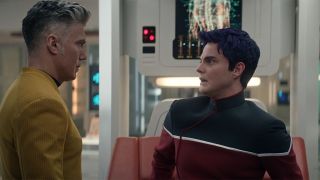
Shared universes go back way further than Tony Stark, Steve Rogers and co sitting down for some post-Chitauri shawarma. Superheroes have been moonlighting in each other's comic books for decades, while Cheers regulars frequently paid Frasier a visit in Seattle. It wasn't until Marvel Studios launched the MCU ( Marvel Cinematic Universe ), however, that the concept started to gain serious mainstream traction.
By incorporating the contrasting adventures of Iron Man, Captain America, Thor and Black Widow into one gigantic, overarching narrative, Marvel successfully blended cinematic spectacle with the "must-watch-every-episode" ethos of serialised TV. The MCU's famous end-credits stings also had the unexpected side-effect of convincing us all to stick around until the end of the closing titles of every movie, y'know, just in case.
From a business point of view it's one of the shrewdest creative decisions ever made in Hollywood, a move that helped turn the MCU into the most lucrative franchise in history, while spawning an army of imitators. Some fell quickly by the wayside — Universal's planned Dark Universe didn't survive beyond its first release, "The Mummy" — while others (most notably DC's original answer to the MCU) simply felt tired in comparison. But with apologies to box-office behemoths Marvel, Star Wars and the Monsterverse home of Godzilla and King Kong, the most exciting shared universe of them all is currently located somewhere on the final frontier.
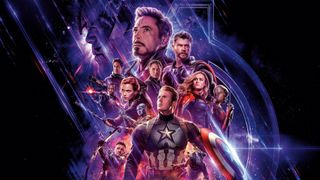
It's not quite "Infinite Diversity in Infinite Combinations" (sorry, Mr Spock), but " Star Trek "'s guiding principle since "Discovery" brought the franchise back to TV in 2017 has been variety. "Discovery" started out as an "Original Series" prequel, before warping off to the even-more-distant future of the 32nd century. That left a gap in the timeline for the less serialized voyages of a pre-Kirk Enterprise in " Strange New Worlds ". "Picard" picked up the story of the ageing Jean-Luc Picard two decades after "The Next Generation" crew's final voyage, while a pair of animated series — kids' show " Prodigy " and all-out comedy "Lower Decks" — were given freedom to take the most daring swings in "Trek" history.
Throw upcoming spy adventure " Section 31 " and cadet-themed "Disco" spin-off " Starfleet Academy " into the mix, and it's clear that — beyond the obligatory warp drives, phasers and frequent violations of the Prime Directive — the main element unifying these very different series is their shared universe. Even their settings are far enough apart — geographically and chronologically — that there's little danger of storylines colliding in Spacedock.
The contrast between the Alpha Quadrant and a certain galaxy far, far away is stark. Until " The Acolyte ", every canonical "Star Wars" movie and TV show had been set within a few generations of the Skywalker family tree. But even ignoring the limitations of that brief timeline, there's a creeping homogeneity to much of the saga's storytelling and dialogue.
Scenes from "The Acolyte" (set around a century before "The Phantom Menace") feel interchangeable with moments in " Ahsoka " (several years after "Return of the Jedi"), while the powers-that-be at Skywalker Ranch seem more preoccupied with plugging holes in existing lore than telling stories for their own sake. What was the final episode of "The Acolyte" season one if not a prequel to the prequel trilogy?

"Star Wars" should be an exhilarating interstellar playground capable of supporting any story you can imagine, but it's increasingly constrained by strict rules that must, it seems, never be broken. "Star Wars" is calling out for its own "Lower Decks"-style comedy" , while the upcoming "'Goonies' in space" " Skeleton Crew " could be the kid-oriented launchpad that Prodigy has been for "Trek". "Star Wars" arguably needs both because right now, all that canon could easily feel daunting to anyone eager to take those precious first steps into a larger world.
Not that the current iterations of "Star Trek" deny the franchise's rich past. The glorious final season of "Picard" was a nostalgia-fest from start to finish, bringing back familiar friends and foes to give the "TNG" crew the send-off they deserved — if it's possible to replicate your cake and eat it, that season showed the way. "Prodigy" also goes big on the deep cuts, but crucially, it doesn't matter if you have no idea that the name of the USS Voyager-A's resident whale (Gillian) is a reference to "Star Trek IV". Or that a mention of the "dysfunctional" crew of the Cerritos is a callback to "Lower Decks". All of the in-jokes are simply window dressing holding the universe together, without excluding newcomers.
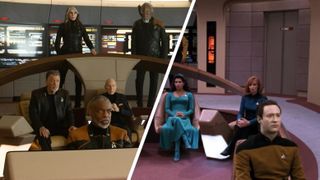
That's the genius of the modern "Star Trek" universe, whose guiding lights clearly understand that expecting every viewer to be up-to-speed with the more than 900 episodes and 13 “Star Trek” movies in the back catalogue would be a surefire route to failure. The MCU and "Star Wars" lived charmed lives when they were built around a relatively small number of movies, but both franchises are now too vast and unwieldy to demand that even casual viewers become completists.
Nobody should have to watch everything , so surely it's better for everyone if we accept that some people will set their targeting computers on "The Mandalorian" but avoid " Andor ", just as some "Discovery" fans can skip "Picard" without feeling they're missing out.
Besides, we probably shouldn't be surprised that it's "Trek" leading the way, because this isn't Starfleet's first away mission to a shared universe. Back in the ’90s "The Next Generation", "Deep Space Nine", "Voyager", four movies and even prequel series "Enterprise" shared characters and plotlines, to the extent that after hundreds of hours of TV, planet Earth was losing interest in shows that were becoming increasingly formulaic. Sound familiar? The franchise's latest overseers have boldly taken note — now "Star Wars", the MCU and the rest should follow in their warp trails.
"Discovery", "Picard", "Strange New Worlds" and "Lower Decks" are all available to stream on Paramount Plus, along with "The Original Series", "The Next Generation", "Deep Space Nine", "Voyager" and "Enterprise". "Prodigy" is available on Netflix.
Join our Space Forums to keep talking space on the latest missions, night sky and more! And if you have a news tip, correction or comment, let us know at: [email protected].
Get the Space.com Newsletter
Breaking space news, the latest updates on rocket launches, skywatching events and more!
Richard's love affair with outer space started when he saw the original "Star Wars" on TV aged four, and he spent much of the ’90s watching "Star Trek”, "Babylon 5” and “The X-Files" with his mum. After studying physics at university, he became a journalist, swapped science fact for science fiction, and hit the jackpot when he joined the team at SFX, the UK's biggest sci-fi and fantasy magazine. He liked it so much he stayed there for 12 years, four of them as editor.
He's since gone freelance and passes his time writing about "Star Wars", "Star Trek" and superheroes for the likes of SFX, Total Film, TechRadar and GamesRadar+. He has met five Doctors, two Starfleet captains and one Luke Skywalker, and once sat in the cockpit of "Red Dwarf"'s Starbug.
This Week In Space podcast: Episode 123 — The Mighty Perseids
10 of Futurama's smartest science references and gags
New Mars terraforming idea: engineered, heat-absorbing dust nanoparticles
- Mars Tafts I have been a Star Trek fan since 1966 and even I don't believe this article. Reply
- Amin Abakery Is this some kind of Joke? Paramount did worse to Star Trek than they did to Halo, than Disney ever did to Star Wars, its an insult not just to science but to morality and human decency. I used to grow up watching star trek, proud that it was written by scientists and good people like her. Now it seems to be written by your average twitter user. With an adulterer Spock and mushroom drive spinning ships. Reply
- View All 2 Comments
Most Popular
- 2 See Mars and Jupiter form 'double planet' early Aug. 14
- 3 Mars orbiter hears the siren song of a salty Red Planet 'mermaid'
- 4 SpaceX Falcon 9 rocket launches for record-tying 22nd time, sending Arctic broadband satellites to orbit (video)
- 5 Marvel and 'Star Wars' take note. 'Star Trek' is now Hollywood's ultimate shared universe
- More to Explore
- Series & Movies
Published Aug 12, 2024
Star Trek's 10 Best Kid-Led Adventures
Here are some of the best Star Trek episodes that put young people in the spotlight.
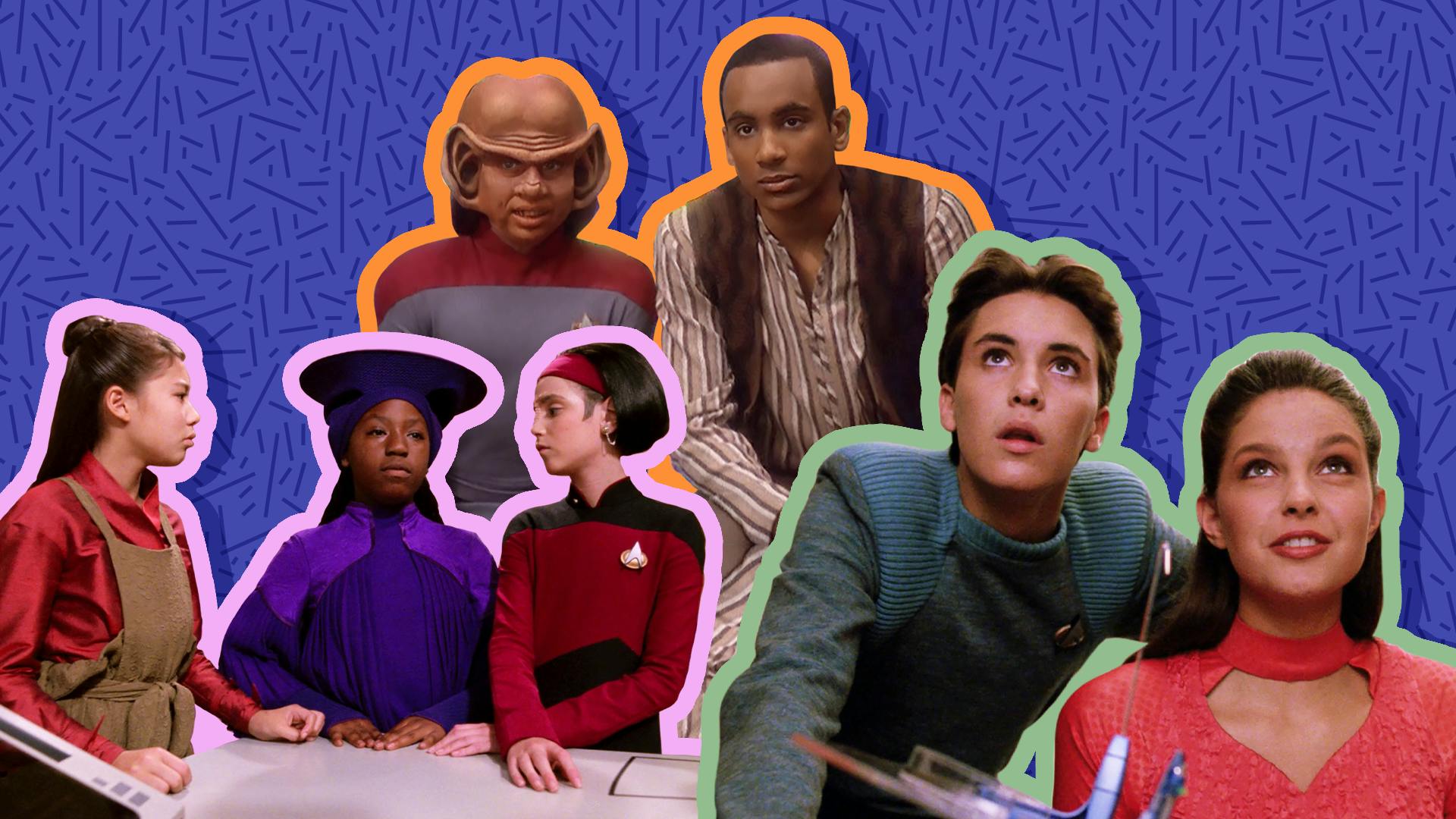
StarTrek.com
Star Trek routinely recognizes the contributions of young people, and there have been plenty of times that a starship has been saved (or captured!) by children. As a kid, watching episodes of Star Trek that featured people my age taking charge made me feel empowered.
So whether you're young or just young at heart, you may also feel inspired by these episodes where kids take the lead!
" Disaster ," Star Trek: The Next Generation

"Disaster"
Captain Picard is famously uncomfortable around children, and so it is always a joy to see him forced to spend time with them. In this fifth-season episode of The Next Generation , the Enterprise loses power and Picard finds himself trapped in a turbolift with three children and a broken ankle.
Despite his insistence that they leave him behind, the kids insist that they all stay together, and we see Picard soften as he relies on their help to escape the turbolift and climb to safety. This episode also features Counselor Troi taking temporary command of the Enterprise (she holds the rank of Lieutenant Commander, after all), as well as the birth of Molly O'Brien!
" Progress ," Star Trek: Deep Space Nine
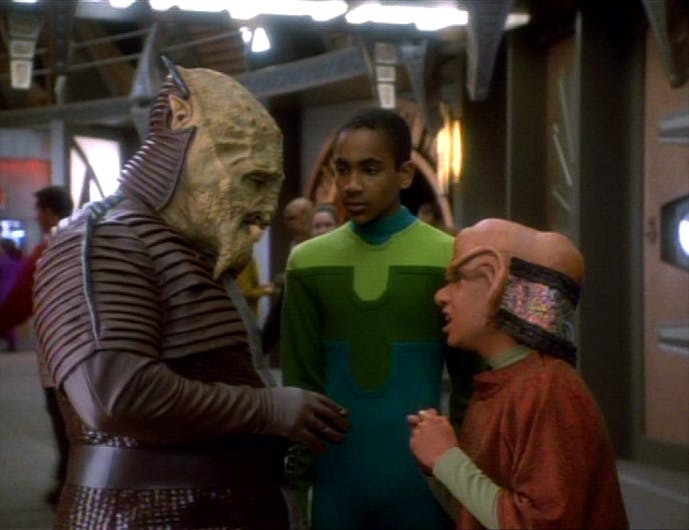
"Progress"
While Deep Space Nine was the grittier, darker series in the Star Trek universe, best friends Jake and Nog always seemed able to make their own fun… and their own trouble. "Progress" is a great example of both.
When Nog overhears that Quark is getting rid of a huge amount of worthless yamok sauce, he and Jake acquire the sauce and embark on a series of trades that begins with the Cardassian condiment and ends with them owning of a parcel of land on Bajor under the name "The Noh-Jay Consortium."
In the end, the boys sell their land to Quark and finally get their latinum. This episode showcases young Jake and Nog's friendship, as well as their negotiating skills and entrepreneurial spirit.
" Miri ," Star Trek : The Original Series
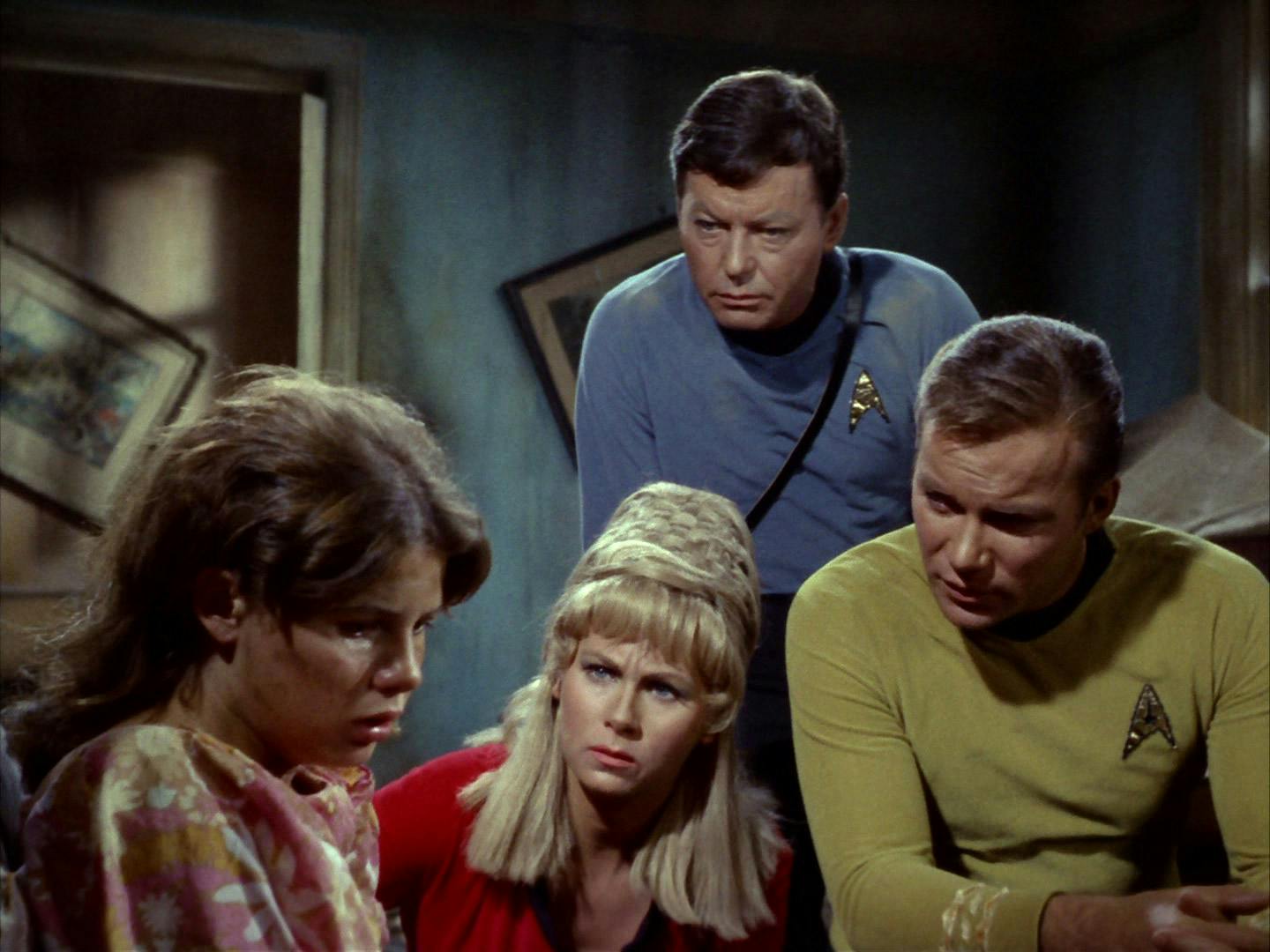
"Miri"
In this Original Series episode, the crew finds a planet that appears similar to 1960s Earth with one difference — a lethal virus kills anyone who has experienced puberty.
Having been exposed when they arrived on the planet, Kirk, McCoy, Spock, Yeoman Rand, and two red shirts are now racing against time to find a cure for the deadly disease. Miri, an older girl, acts as the landing party's guide and defender, helping the crew regain lost equipment in order to create a vaccine. The children of this world are then able to live without fear of the virus, and with only a normal amount of fear of puberty.
" The Naked Now ," Star Trek: The Next Generation
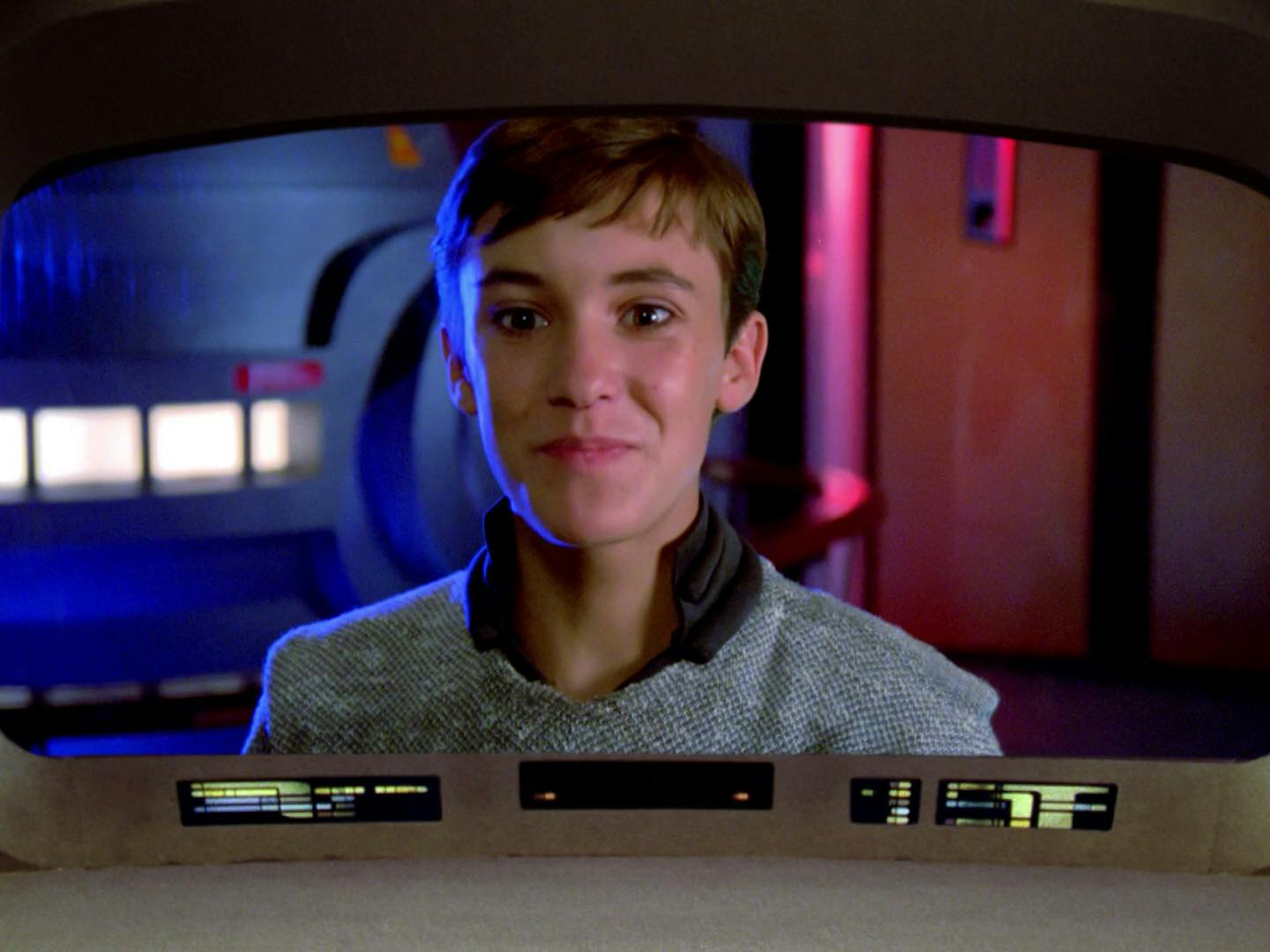
"The Naked Now"
After encountering a research vessel whose entire crew has perished from an unknown disease, the Enterprise 's crew soon finds themselves infected with an illness that lowers inhibitions and causes a state of extreme intoxication. An afflicted Wesley does what any teen would do — he tricks the engineering crew into a force field and effectively takes control of the ship.
When the adults manage to retake Engineering, a compromised Wesley still finds a way to propel the ship away from a collapsing star, saving them all. This episode serves as a sequel to the Original Series episode " The Naked Time ," which featured the same sickness (resulting in a swashbuckling Sulu). Fans will also remember this as the episode when Data and Security Chief Tasha Yar are, in Data's words, "intimate."
" Collective ," Star Trek: Voyager

"Collective"
When the Delta Flyer stumbles upon a malfunctioning Borg Cube, Chakotay, Paris, and Neelix are taken hostage by a group of five juvenile drones, the only survivors of a plague that wiped out the rest of the ship. In the end, Seven is able to talk the children into relinquishing control and leaving their Borg life behind them.
The process of shedding conformity and embracing one's own individuality is a natural part of adolescence, although there are usually fewer cybernetic implants involved. Added bonus — Borg baby!
" And The Children Shall Lead ," Star Trek: The Original Series
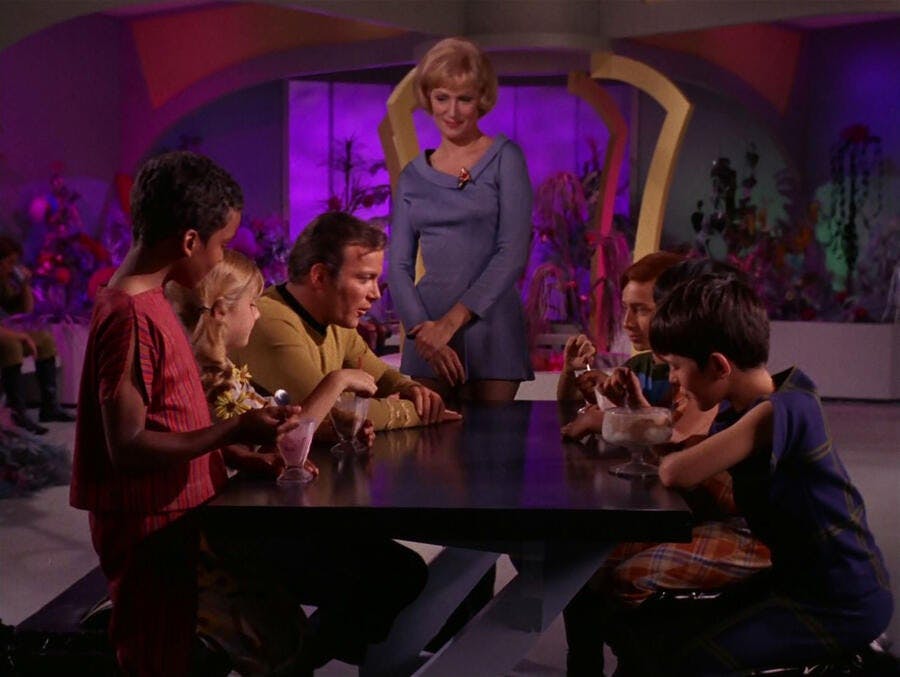
"And The Children Shall Lead"
The Enterprise discovers a team of dead scientists, and five surviving children who have been given psychic powers by a mysterious humanoid named Gorgan. Typical stuff, really. The kids nearly succeed in taking over the ship, but Kirk's "innate goodness" (in the words of Gorgan) allows him to overcome their psychic grasp. It isn't clear whether the children were under the influence of Gorgan the whole time or if they were just on a pint-sized power trip, but either way they are so grounded!
" Rascals ," Star Trek: The Next Generation
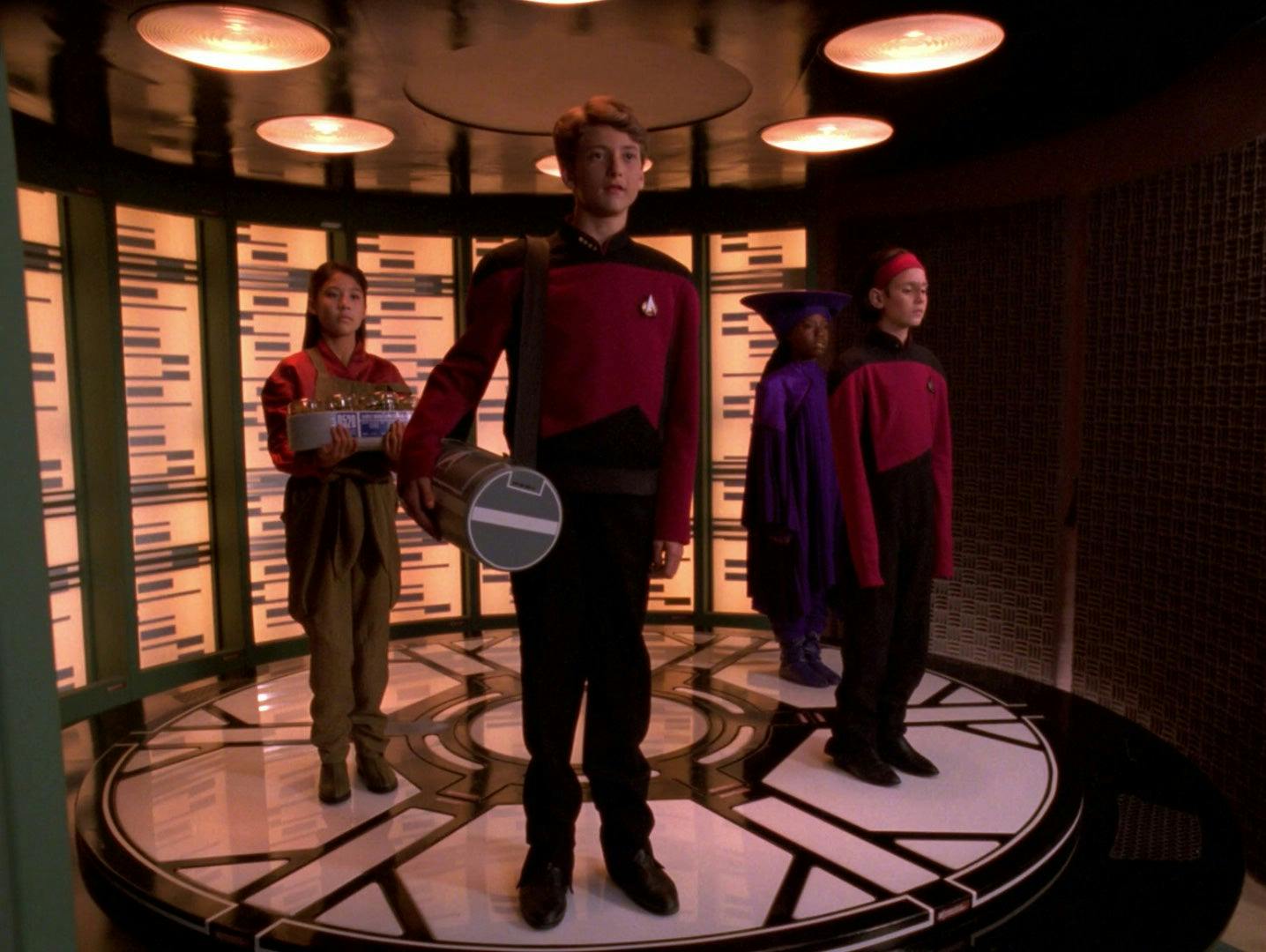
"Rascals"
We've seen our fair share of transporter accidents in the Star Trek universe, from melding two crew members together, to creating an evil twin. But no transporter mishap is stranger than the one that transforms Captain Picard, Guinan, Ensign Ro Laren, and Keiko O'Brien into 12-year-old versions of themselves.
Don't think too much about the physics, and instead focus on how satisfying it is when the tween dream team uses a classroom computer to neutralize the invaders. We're used to our crew being responsible and serious, so it's a treat to see 12-year-old Picard posing as Riker's son and throwing a tantrum. On a sweet closing note, Ensign Ro, deprived of a carefree childhood on occupied Bajor, delays returning to adulthood so that she can enjoy being a kid for the first time.
" In the Cards ," Star Trek: Deep Space Nine
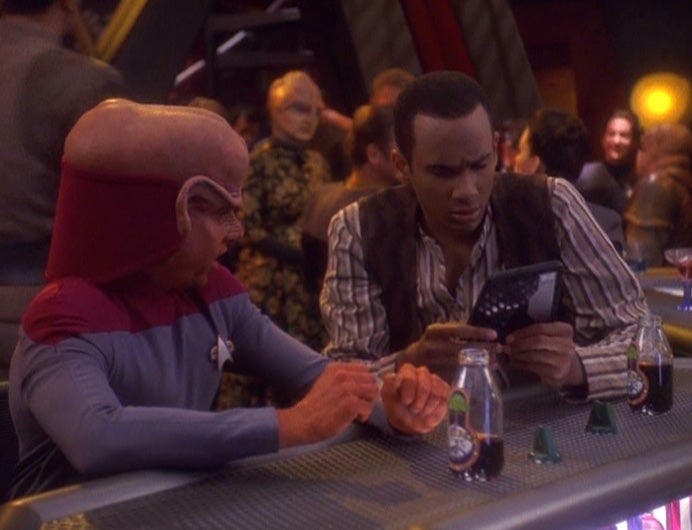
"In the Cards"
While Jake and Nog's teenage mischief usually lived in the B plots, this episode took them front and center. Jake wants to buy a Willie Mays baseball card for his father at Quark's auction, but an eccentric doctor outbids him. Nog then spearheads a series of favors and barters for the card, bettering the day of everyone in their path, even a suspicious and menacing Weyoun.
Watching Jake and Nog's friendship evolve as they grow up is one of the best parts of Deep Space Nine , and as this series prepared to go into dark territory with the Dominion War this episode served as a good reminder of what the Federation was fighting for.
" The Game ," Star Trek: The Next Generation
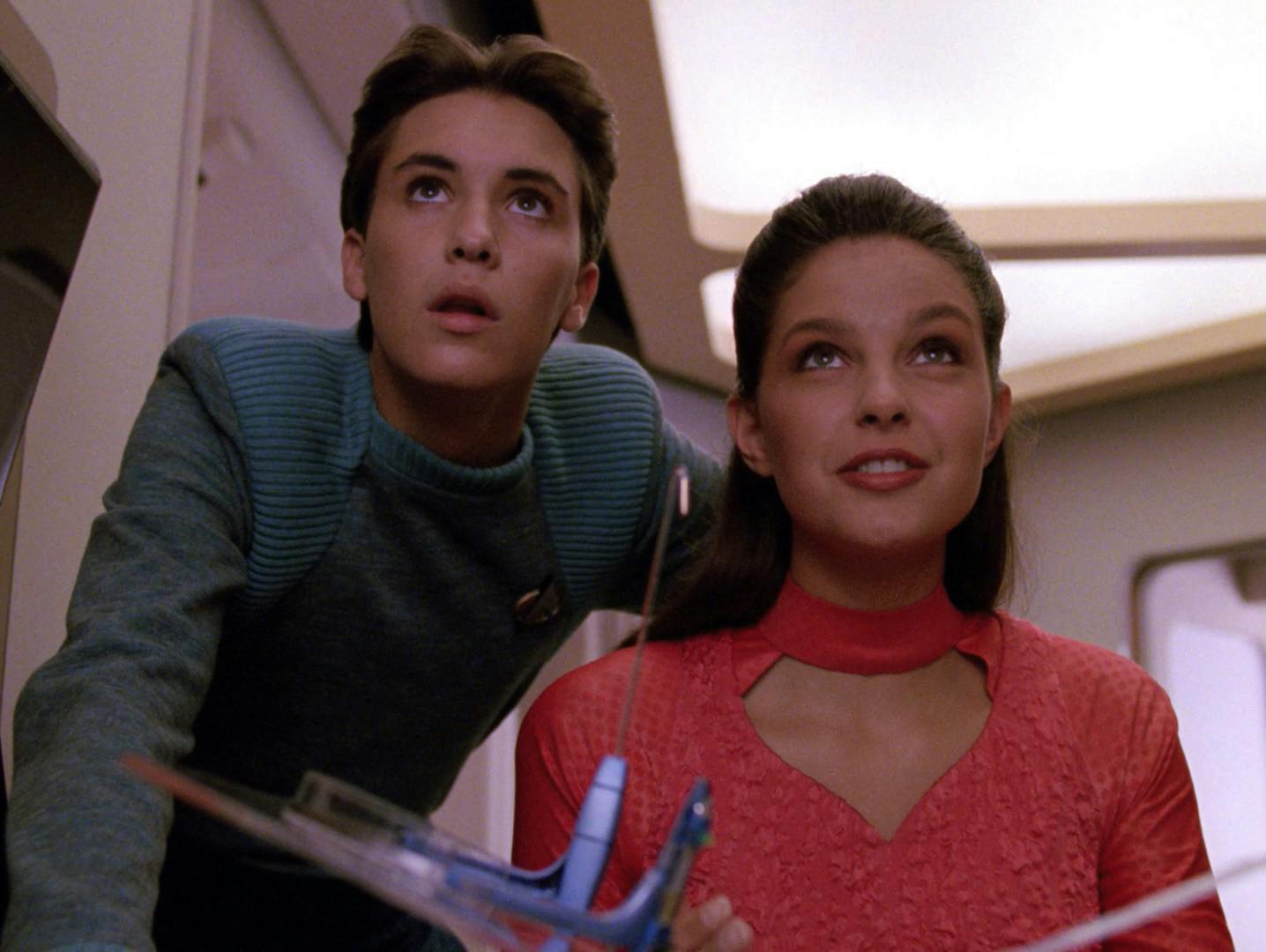
"The Game"
Riker returns from a vacation on Risa with a game that turns out to be addictive and places the crew under a kind of mind control. Wesley, with the help of Ensign Robin Lefler (guest star Ashley Judd) realize something's wrong and races to reverse the effects of the game before they're forced to play.
They manage to reactivate Data, who had been neutralized by Dr. Crusher, and he cures the crew just as Riker's fling from Risa shows up to take control of the Enterprise . This episode teaches us that we should not give in to peer pressure, and that we should not trust everyone we meet on Risa.
" The Corbomite Maneuver ," Star Trek: The Original Series
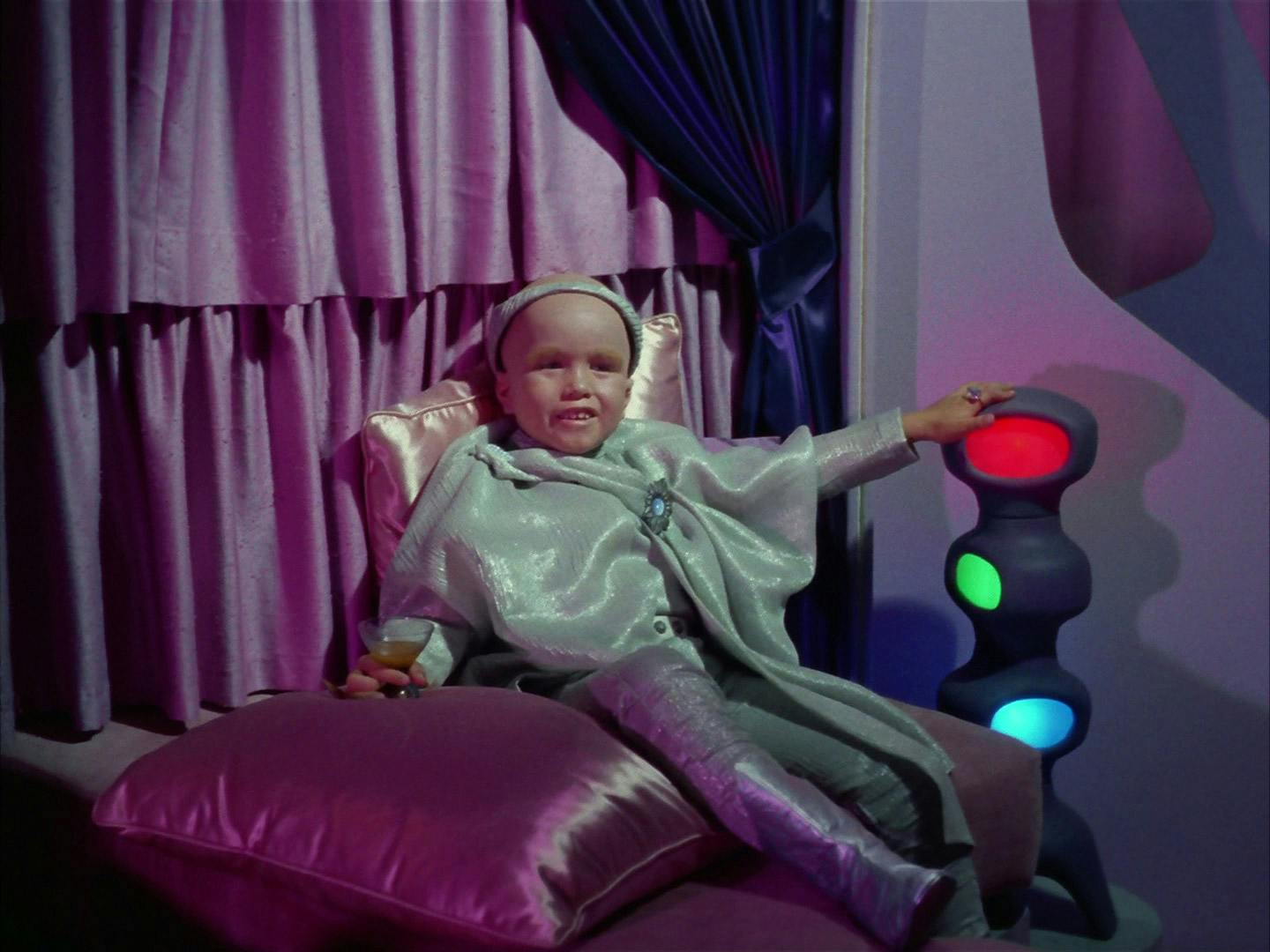
"The Corbomite Maneuver"
The Enterprise is trapped by Commander Balok, who appears on their viewscreen as an imposing blue-skinned figure. Kirk bluffs his way out of this stand-off by claiming that his ship is carrying "corbomite," a highly explosive material that would destroy both ships if ignited. The ruse works and the crew soon discovers that Balok is actually a child (played by Clint Howard) with a penchant for mischief and a now-iconic beverage called tranya. While Howard doesn’t get much screen time, his iconic turn as the child-like Balok continues to be one of the most recognizable references to Original Series in popular culture.
These certainly are not the only times in the Star Trek universe when young people took charge. Star Trek shows us that we all have the ability to save the day, and that age truly is nothing but a number. Pass the tranya and enjoy!
Get Updates By Email
This article was originally published on August 12, 2020.
Erin Foley-Chan (she/her) is a freelance writer and producer based in New York City. She can be found on Twitter @erinfoleychan, and on her couch using her dog as a blanket.
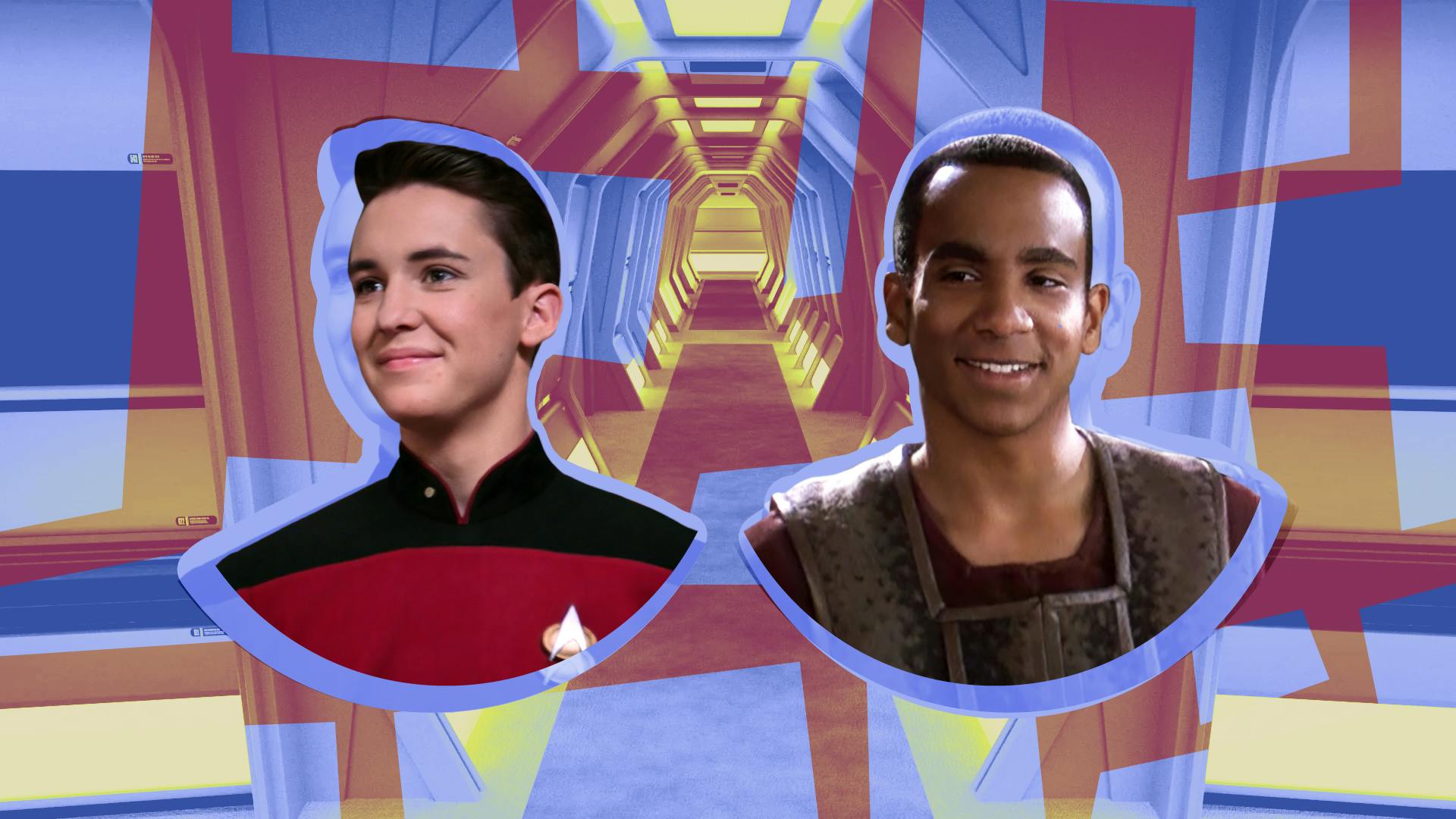
- Cast & crew
- User reviews
- Episode aired Jan 2, 1994

Quark meets his match when a new rival opens a casino opposite his bar on the Promenade. Meanwhile, the station is suffering issues of high improbability. Quark meets his match when a new rival opens a casino opposite his bar on the Promenade. Meanwhile, the station is suffering issues of high improbability. Quark meets his match when a new rival opens a casino opposite his bar on the Promenade. Meanwhile, the station is suffering issues of high improbability.
- David Livingston
- Gene Roddenberry
- Rick Berman
- Michael Piller
- Avery Brooks
- Rene Auberjonois
- Alexander Siddig
- 11 User reviews
- 3 Critic reviews

Top cast 29

- Commander Benjamin 'Ben' Sisko

- Constable Odo

- Doctor Julian Bashir
- (as Siddig El Fadil)

- Lt. Jadzia Dax

- (credit only)

- Chief Miles O'Brien

- Major Kira Nerys

- Keiko O'Brien

- Martus Mazur
- Starfleet Medical Officer
- (uncredited)

- Starfleet Science Officer
- Star Fleet Crew Member
- Starfleet Ops Lieutenant
- Michael Piller (showrunner)
- All cast & crew
- Production, box office & more at IMDbPro
Did you know
- Trivia Michael Piller conceived Martus Mazur to be the wayward son of Guinan. Guinan herself was to appear in the episode but Whoopi Goldberg was unavailable. All the references to Guinan were removed and only Martus's status as an El-Aurian was retained.
- Goofs When Jadzia Dax is trying to discover the cause of the high number of accidents happening on the station, checking the solar neutrinos she discovers something unusual "...about half of them should be spinning clockwise and the other half counter clockwise." Since she notices that over 80% of them are spinning clockwise, she concludes that something is interfering with the neutrinos. Unfortunately all three known types of neutrinos have left-handed spin (anti clockwise).
Quark : [Rule of Acquisition #109] Dignity and an empty sack is worth the sack.
- Connections Featured in Star Trek: Deep Space Nine: What You Leave Behind (1999)
- Soundtracks Star Trek: Deep Space Nine - Main Title (uncredited) Written by Dennis McCarthy Performed by Dennis McCarthy
User reviews 11
- Feb 17, 2022
- January 2, 1994 (United States)
- United States
- Official Site
- Paramount Studios - 5555 Melrose Avenue, Hollywood, Los Angeles, California, USA (Studio)
- Paramount Television
- See more company credits at IMDbPro
Technical specs
- Runtime 46 minutes
Related news
Contribute to this page.
- IMDb Answers: Help fill gaps in our data
- Learn more about contributing
More to explore
Recently viewed.
‘Star Trek: Deep Space Nine’ Foreshadowed a Terrible Fate in Its 1995 Episode That is Eerily Similar to 1 Harrowing Real-Life Incident in 2024
One episode of Star Trek: Deep Space Nine seems to have mirrored a real-life political policy that is proposed by the current governor of California.
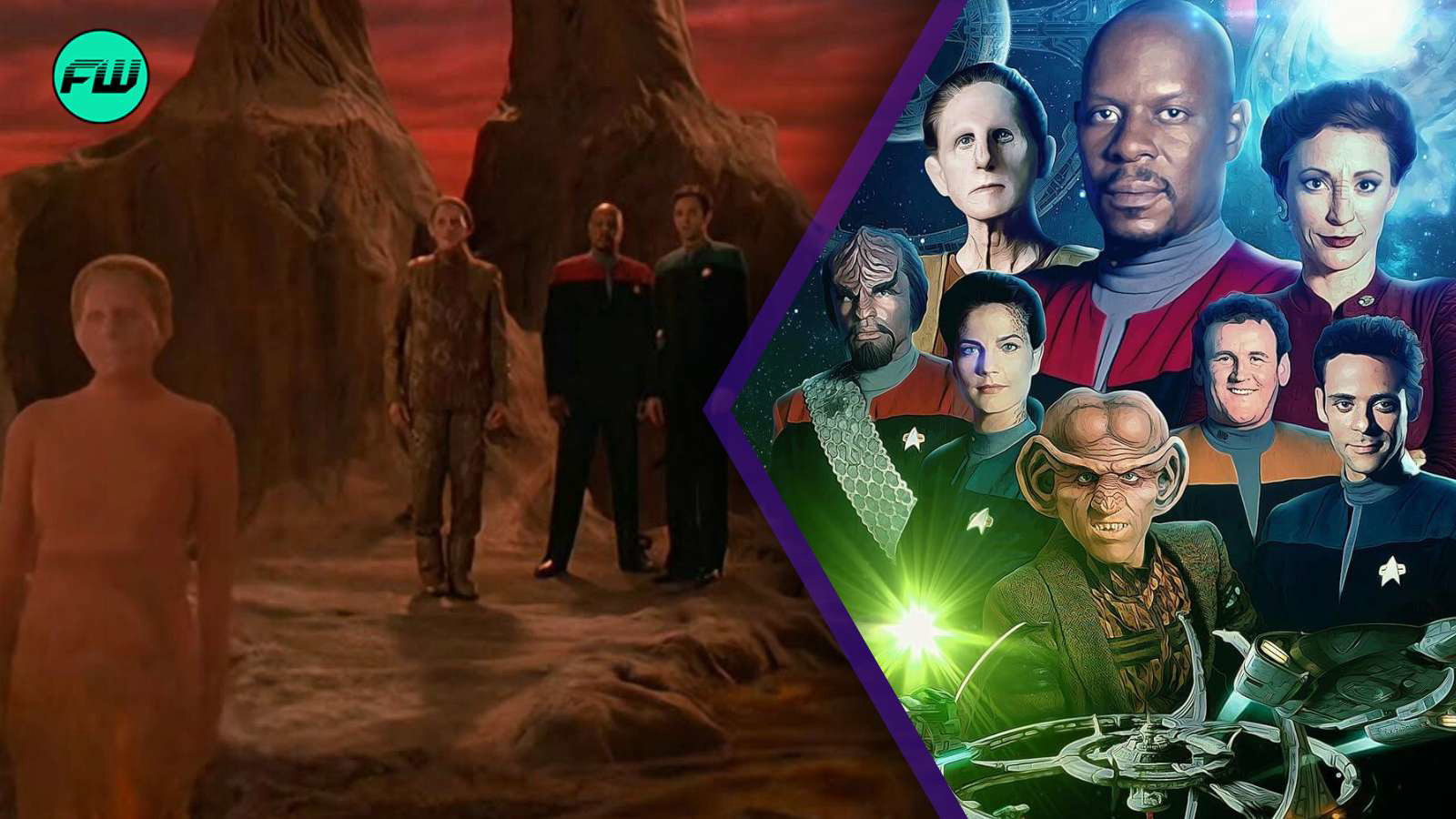
- Gene Roddenberry's Star Trek franchise has always depicted a hopeful vision for the future where inclusivity and diplomacy is celebrated.
- However, the storyline of the spinoff show Deep Space Nine indicated that the peaceful future was preceded by tumultuous times, which had riots.
- One episode in the show seems to have predicted one topical event and moreover, the episode was set in the show's distant past of 2024.
The spinoff show Star Trek: Deep Space Nine seems to have gone The Simpsons’ route this election season and predicted a political policy back in 1995, that might come into effect in California now. Moreover, the episode in question was also reportedly set in 2024, making the prediction all the more eerie and accurate.
The episode ‘ Past Tense ’ sees the world in 2024 crumbling due to rising homelessness, which is attempted to be eradicated by the politicians by sending the homeless to encampments known as Sanctuaries. This ideology has been compared to Californian Governor Gavin Newsom’s latest policy on homelessness eradication.
Star Trek: Deep Space Nine Predicted A Current Event In 2024
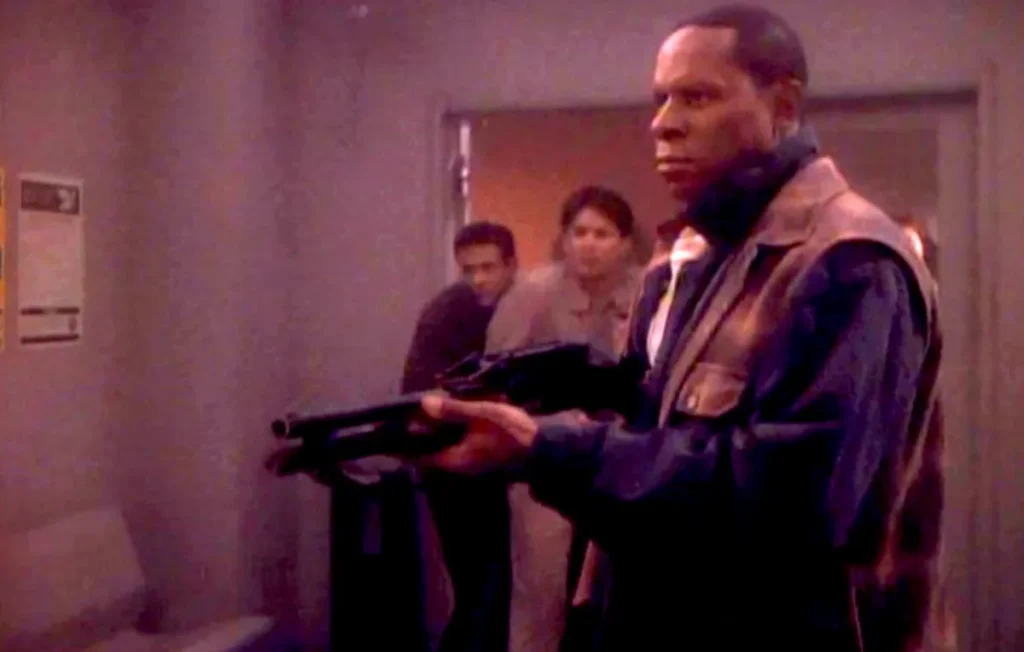
Gene Roddenberry’s Star Trek franchise has always depicted a hopeful image of the future, where inclusivity and diplomacy take precedence over other victories. Violence in the show is kept to a minimum and discoveries and wonder are often encouraged. Be it the original series or its spinoffs, the future of Star Trek has always been positive.
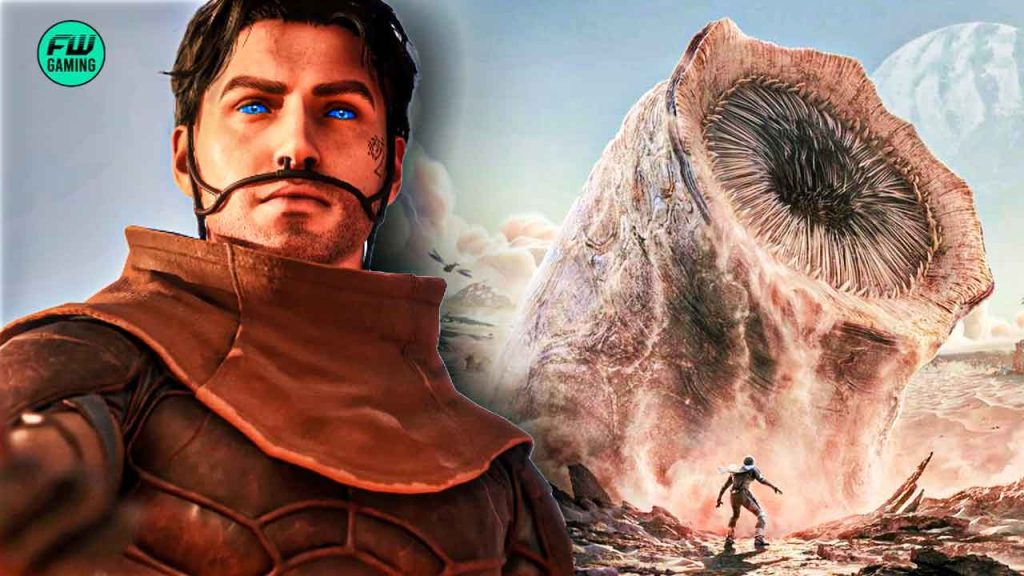
“We wanted to create a space for players to roleplay”: Dune: Awakening Will Let You Live Your Deepest Arrakis Dreams (With Your Friends)
However, this hopeful future is canonically established to have been the result of a riot that came from utmost oppression. The Star Trek: Deep Space Nine episode ‘ Past Tense ’ actually put three members of the crew, Commander Sisko, Dr. Bashir, and Jadzia Dax in the show’s past i.e. 2024, days before the ‘Bell Riots’ took place.
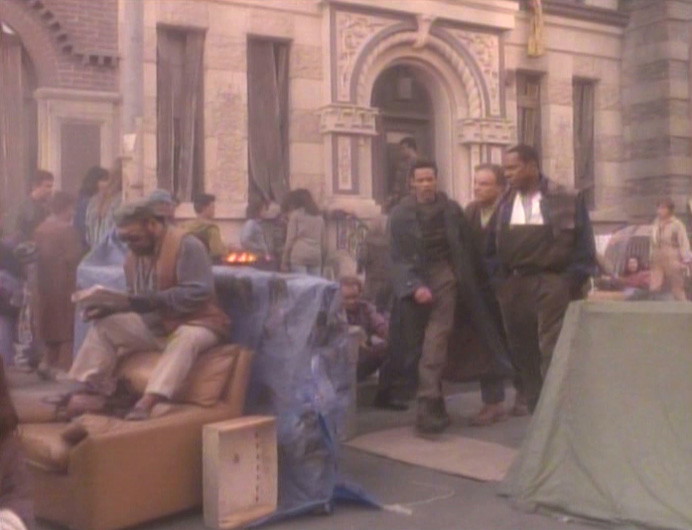
The episode sees the world being plagued by homelessness and a section of society not being able to support themselves being cordoned off into encampments in a place called the ‘Sanctuary District’. While the writers of the show were reportedly inspired by what they saw in the ‘90s, a new executive order in 2024 seemed to have eerie similarities.
According to CBS News , California Governor Gavin Newsom had recently issued an order to eradicate homeless encampments from under freeways and other settlements. The order reportedly mentioned that local authorities had the discretion to carry out these orders, however, there were possibilities of the department applying pressure.
Star Trek: Deep Space Nine Writers Said That They Were Responding To What They Saw
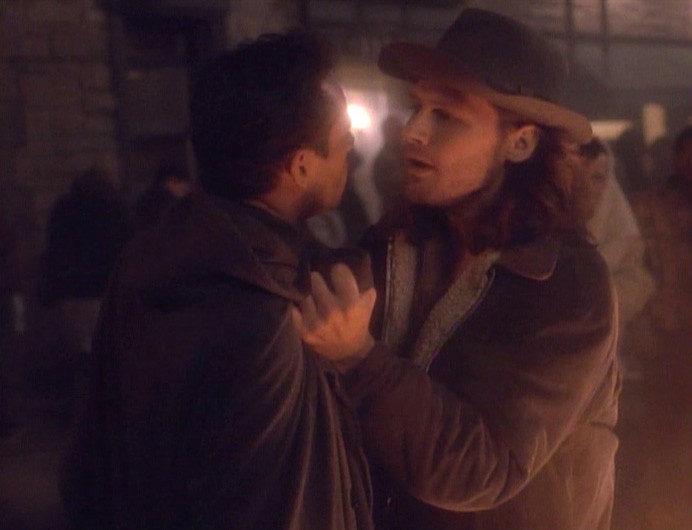
Sci-fi media predicting the future has always been a subject of intrigue as it indicates that not much has changed in the world since the piece was conceived. Despite technological advancements, the social and political mood of the world still seemed to be status quo.

“My only question was…”: LeVar Burton Had an Oddly Specific Ask Before Joining Star Trek: The Next Generation
Star Trek: Deep Space Nine writer Robert Wolffe mentioned to Vox that they only got the advanced level of computers wrong in the 2024 past/future that they wrote in ‘ Past Tense’ . He said,
We weren’t being predictive. We were just looking out our windows in the ’90s. My wife worked with homeless and mentally ill people as a psychotherapist. Ira [Steven Behr] said what convinced him to do the episodes was walking through Palisades Park in Santa Monica and seeing all the homeless people there. They’re still there. It hasn’t changed. We weren’t being predictive. We were just being observant.
When production on the episode was wrapping up, the makers reportedly met with the news that LA mayor Richard Riordan was planning on removing homeless encampments and sending them to cordoned-off spaces called ‘havens’, which became another eerie prediction.
Star Trek: Deep Space Nine is available to stream on Paramount+.
Star Trek: Deep Space Nine
Written by Nishanth A
Nishanth A is a Media, English and Psychology graduate from Bangalore. He is an avid DC fanboy and loves the films of Christopher Nolan. He has published over 1,000 articles on FandomWire. When he's not fixating on the entire filmography of a director, he tries to write and direct films.
Copyright © 2024 FandomWire, LLC. All rights reserved.

A Star Trek icon isn't likely to return to the franchise
S tar Trek has seen a resurgence in recent years of returning characters and actors to the franchise. Leads of Star Trek shows like Patrick Stewart, Kate Mulgrew, and others have popped in and out of the franchise in recent years, reprising roles for Picard, Lower Decks, and Prodigy, while also seeing various characters return for Strange New Wolds, Discovery, and other shows as well.
Yet, not everyone has returned or even wants to. Having featured and then later starred on both the Next Generation and Deep Space Nine respectively, Colm Meaney has seemingly shut the door on ever returning.
Formerly a recurring cast member on The Next Generation, Meaney played Miles O'Brien, a minor background character, who would go on to play a major role on Deep Space Nine. One of the starring characters, O'Brien went from a somewhat seen character to truly one of the best parts of Deep Space Nine.
Yet, it looks like his time in space is over, according to a new interview with Comic Book Movie 's website.
"I think seven years in a space suit was enough, you know? I'm often asked that question and you never say never, of course, but first of all I wouldn't fit in it anymore [Laughs] and...I remember people saying at the time when Voyager got going, 'How many times can you go to the well? How many times can you revamp this? ...They successfully did it with Star Trek and they're still doing it. Good luck to them. Do you want to see an elderly Miles O'Brien? I don't know. It's certainly not at the top of my agenda of things I'd like to do at the moment."
Meaney, now 71, has had a long career since Deep Space Nine ended and has been working regularly ever since. He's in high demand still and isn't looking to slow down his workload by any means. That's not to say he couldn't fit some time in with Starfleet, but it does seem like he's ok if he never wears the uniform again.
With so many people returning, among those who want to return, it doesn't make much sense to pine over someone content with that part of his life being done.
This article was originally published on redshirtsalwaysdie.com as A Star Trek icon isn't likely to return to the franchise .


IMAGES
COMMENTS
Star Trek: Deep Space Nine is the third live-action television series in the Star Trek franchise and aired in syndication from January 1993 through June 1999. There were a total of 173 (original broadcast & DVD) or 176 (syndicated) episodes over the show's seven seasons, which are listed here in chronological order by original airdate, which match the episode order in each season's DVD set.
Star Trek: Deep Space Nine: Created by Rick Berman, Michael Piller. With Avery Brooks, Rene Auberjonois, Cirroc Lofton, Alexander Siddig. In the vicinity of the liberated planet of Bajor, the Federation space station Deep Space Nine guards the opening of a stable wormhole to the far side of the galaxy.
S5.E22 ∙ Children of Time. Mon, May 5, 1997. The DS9 crew discovers a small colony on a remote world that was originally populated by them 200 years earlier due to a time-travel accident with the Defiant. The current colonists lives depend on making sure that accident happens again, even though they've now forwarned the crew that it will happen.
Star Trek: Deep Space Nine (DS9) is an American science fiction television series created by Rick Berman and Michael Piller.The fourth series in the Star Trek media franchise, it originally aired in syndication from January 3, 1993, to June 2, 1999, spanning 176 episodes over seven seasons. [2] Set in the 24th century, when Earth is part of a United Federation of Planets, its narrative is ...
S1.E4 ∙ A Man Alone. Sun, Jan 17, 1993. Ibudan, a criminal Odo has dealt with before, returns to DS9 only to be murdered shortly after - leaving Odo to be the prime suspect. Jake and Nog's trouble-making prompt Keiko to do something helpful for the station's children. 6.8/10 (2.7K) Rate.
Star Trek: Deep Space Nine. STAR TREK: DEEP SPACE NINE takes place in the mid-24th century and chronicles the adventures of a team of Starfleet officers who take command of a remote alien space station on the edge of a new frontier. Stream Star Trek: Deep Space Nine free and on-demand with Pluto TV. Free Movies & TV Shows.
Star Trek: Deep Space Nine - The seasons, the key episodes. Season 1 - Like all of the "new" Star Trek series, Deep Space Nine required a warmup period. Through seasons 1 and 2, the "A" listers of the Star Trek writing/production team were assigned to The Next Generation while DS9 was left with the generic sorts of plots that allowed exploration of character: Episodes like "Past ...
Star Trek: Deep Space Nine was the fourth Star Trek series and entered production in 1992. It was broadcast in first-run syndication from January 1993 until June 1999. It was the first Star Trek series created by Rick Berman and Michael Piller rather than by Gene Roddenberry. It was also the only series to air alongside another Star Trek production throughout its entire run, airing alongside ...
A spinoff of "Star Trek: The Next Generation," "Deep Space Nine" is set on a space station near the planet Bajor. This time, Commander Benjamin Sisko is in charge of a diverse crew. But unlike other "Star Trek" series, there's no USS Enterprise to help them. Sisko and the crew must fight off rival alien species who want control of Deep Space ...
Star Trek: Deep Space Nine chronicles the adventures of Captain Benjamin Sisko and a team of Starfleet officers who take command of a remote space station on the edge of a frontier and a critical crossroads of galactic events. 7 seasons • 176 episodes • 1993-1999
A spinoff of "Star Trek: The Next Generation," "Deep Space Nine" is set on a space station near the planet Bajor. This time, Commander Benjamin Sisko is in charge of a diverse crew. But unlike ...
Star Trek: Deep Space Nine - watch online: streaming, buy or rent. Currently you are able to watch "Star Trek: Deep Space Nine" streaming on Paramount Plus, Paramount Plus Apple TV Channel , Paramount+ Amazon Channel, Paramount+ Roku Premium Channel or for free with ads on Pluto TV. It is also possible to buy "Star Trek: Deep Space Nine" as ...
Trials and Tribble-ations - Ah, yes, one of the crowning jewels of Star Trek Deep Space Nine and worthy of inclusion on nearly any Top 10 or Top 20 Star Trek Episodes-type listicle. Six of the DS9 bridge crew chase a Klingon criminal into the past, when Deep Space 9 was smaller and was visited by the crew under command of one James T. Kirk ...
A spinoff of "Star Trek: The Next Generation," "Deep Space Nine" is set on a space station near the planet Bajor. This time, Commander Benjamin Sisko is in charge of a diverse crew. But unlike other "Star Trek" series, there's no USS Enterprise to help them. Sisko and the crew must fight off rival alien species who want control of Deep Space ...
A guide listing the titles AND air dates for episodes of the TV series Star Trek: Deep Space Nine. ... my shows | like | set your list <preferences> Star Trek: Deep Space Nine (a Titles & Air Dates Guide) Last updated: Wed, 10 Jan 2024 2:00 . Show Details: Start date: Jan 1993 End date: Jun 1999 Status: cancelled/ended Network(s): syndicated ...
Entertainment Weekly has called DS9 "the Trek franchise's most compelling series." Here's 10 episodes that prove it.Read the article here: https://whatcultur...
Avery Brooks directed the stirring episode, which sees Sisko have a vision of himself living as a sci-fi writer in the 1950s, where he deals with racism on a daily basis. "It is the very best of ...
S1 E15. May 10, 1993. Bajor's fifth moon Jeraddo must be evacuated to make way for a much-needed power plant for the home planet, but one old codger refuses to evacuate. Brian Keith guest stars as Mullibok, who forces Kira to realize just how much she and Bajor have changed in a few short months.
The rosy vision of the future at the core of Star Trek-- with its improbably well-adjusted human race and largely harmonious universe - was long overdue for reassessment, and Deep Space Nine did ...
Season 1, Episode 1. Original airdate: January 3, 1993. Deep Space Nine's pilot opens during a pivotal confrontation in Federation history, against the Borg in the Battle of Wolf 359. Aboard the ...
Star Trek: Deep Space Nine's cast in season five, after Michael Dorn (Worf) had joined in season four and before Terry Farrell (Jadzia Dax) left at the end of season six. Star Trek: Deep Space Nine is an American science fiction television series that debuted in broadcast syndication on January 3, 1993. [1] The series ran for seven seasons until 1999. [2]
Deep Space Nine's era in the Star Trek timeline was one marked by war, and death was a frequent part of the long-running storylines. Some of the most prominent deaths of DS9 cast members - like that of Miles O'Brien and Benjamin Sisko - can be put down to time travel shenanigans, but Jadzia Dax's death was permanent and came thanks to behind ...
Paradise: Directed by Corey Allen. With Avery Brooks, Rene Auberjonois, Alexander Siddig, Terry Farrell. Sisko and Chief O'Brien discover a colony which lives without technology.
Richard's love affair with outer space started when he saw the original "Star Wars" on TV aged four, and he spent much of the '90s watching "Star Trek", "Babylon 5" and "The X-Files" with ...
While Deep Space Nine was the grittier, darker series in the Star Trek universe, best friends Jake and Nog always seemed able to make their own fun… and their own trouble. "Progress" is a great example of both. When Nog overhears that Quark is getting rid of a huge amount of worthless yamok sauce, he and Jake acquire the sauce and embark on a series of trades that begins with the Cardassian ...
Rivals: Directed by David Livingston. With Avery Brooks, Rene Auberjonois, Alexander Siddig, Terry Farrell. Quark meets his match when a new rival opens a casino opposite his bar on the Promenade. Meanwhile, the station is suffering issues of high improbability.
Star Trek: Deep Space Nine writer Robert Wolffe mentioned to Vox that they only got the advanced level of computers wrong in the 2024 past/future that they wrote in 'Past Tense'.He said, We weren't being predictive. We were just looking out our windows in the '90s. My wife worked with homeless and mentally ill people as a psychotherapist.
A Star Trek: The Next Generation and Deep Space Nine cast member has seemingly shut the book on a return. ... Leads of Star Trek shows like Patrick Stewart, Kate Mulgrew, and others have popped in ...